Paul van Yperen's Blog, page 414
July 3, 2014
Francesca Bertini
'1914: Cinema of A Hundred Years Ago' is one of the sections of Il Cinema Ritrovato. Tonight, the centennial will be celebrated with an evening screening of the epic Cabiria (Giovanni Pastrone, 1914) at the Teatro Comunale in Bologna, including the original choral and orchestral score restored by Timothy Brock. The section also presents European and American films about ancient worlds and contemporary conflicts, pacifist films and imperialist films, the first anti-war masterpiece (Maudite soit la guerre by Alfred Machin), films on female charm and fashion, and of course the diva films. The most famous diva film of the year was Sangue Blu (Giovanni Pastrone, 1914), starring Francesca Bertini (1892-1985). During the first quarter of the twentieth century this majestic diva of the Italian silent cinema often played the 'femme fatale', with men devouring eyes, glamorous attire, clenched fists, and in opulent settings...

Italian postcard by Fotocelere, Torino, no. 324.
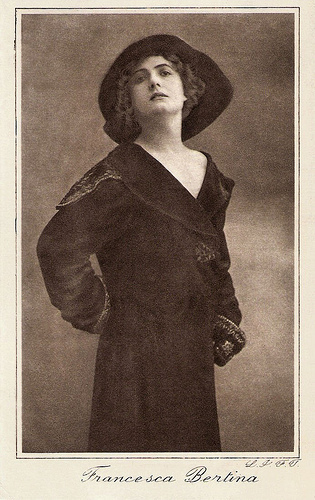
Vintage postcard by L.I.F.J.

Italian postcard by La Rotofotografica, no. 44. Photo: Unione Cinematografica Italiana, Roma.

Italian postcard by Ed. G. Vettori, Bologna, no. 244.

Italian postcard by Ed. G. Vettori, Bologna, no. 2029.
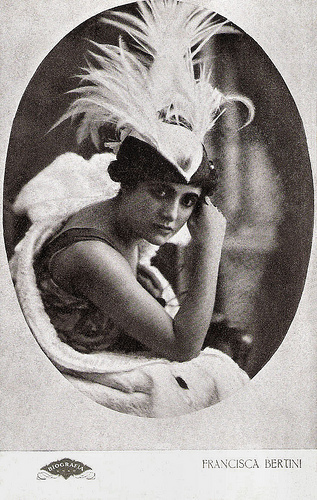
Czech postcard by Verlag Biografia, Kunstfilm G.m.b.H, Prag.
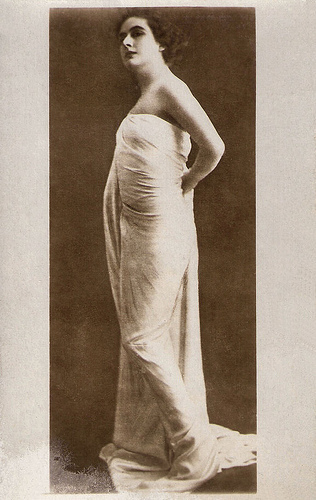
Italian postcard by Visto Censura, Torino, no. 6183-9-10-15.
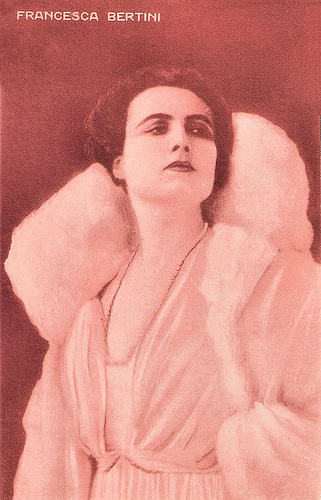
Belgian postcard. Sent by mail in 1922.
Strong, Intense, and Charming Personality
Francesca Bertini was born Elena Seracini Vitiello in Firenze (Florence), Italy in 1892. She was the daughter of a comic theatre actress.
Bertini began performing on stages as a child, particularly in Naples, where her family was settled. In 1904, at the age of 16, she moved to Rome, where she improved her acting skills, especially on theatre stages, and attempted to perform in the just-born Italian cinema.
She made her film debut in La dea del mare (1907). She appeared in one-, two- and three-reelers for the Italian pioneering companies Cines and Celio. Gradually she developed her beauty and elegance, plus a strong, intense, and charming personality, which would be the key of her success as a silent film actress.
Her first important film was Histoire d'un pierrot/Pierrot the Prodigal (Baldassarre Negroni, 1914). Soon followed by appearances in L'amazzone mascherata/The Masked Amazon (Baldassarre Negroni, 1914), Sangue blu/Blue Blood (Nino Oxalia, 1914) and a small part in the successful historic epic Cabiria (Giovanni Pastrone, 1914).
Bertini was the most versatile of the big three Italian Divas - Bertini, Lyda Borelli , and Pina Menichelli . Her strong face and dignified suffering carried a large number of films, now mostly lost.
However, one of her most impressive films has survived: Assunta Spina (Francesca Bertini, Gustavo Serena, 1914). David Melville reviews on IMDb : "Assunta Spina is a work of dazzling dramatic intensity - with a heroine who is striking in her sensuality and modernity. Unlike the languid paper dolls who populate silent films by Griffith and others, Francesca Bertini plays a fully sexual woman. A vulnerable but hard-headed child of the slums, she's not above flirting with a man who's not her fiance, or - once the fiance goes to jail for attacking her in a jealous rage - prostituting herself to an official in order to save him. Not a Madonna, not a whore, but a woman. Perhaps the first real woman in screen history."
Bertini did not just play the role of the main character, but she also wrote the script, directed and produced the film. Later she directed herself again in one of her other famous roles, Tosca, in La Tosca (1918).
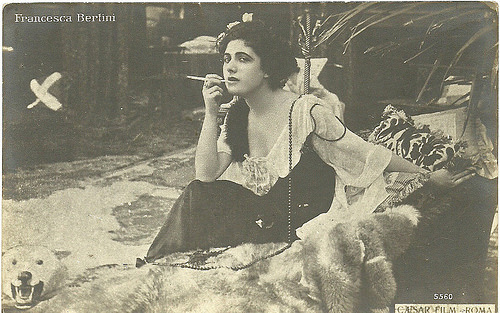
Italian postcard, no. 5560. Photo: Caesar Film, Roma. Collection: Didier Hanson.
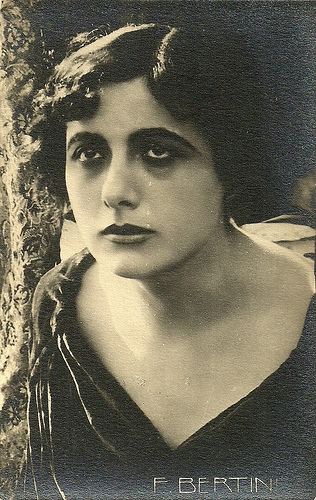
Italian postcard by Cine-Excelsa. Photo: Officine foto-artistiche Sborgi, Firenze.

Italian postcard by G. Vettori, Bologna, no. 136.

Italian postcard by G. Vettori, Bologna, no. 290. Sent by mail in 1927.

Italian postcard, no. 382. Photo: probably a publicity still for Assunta Spina (1914).
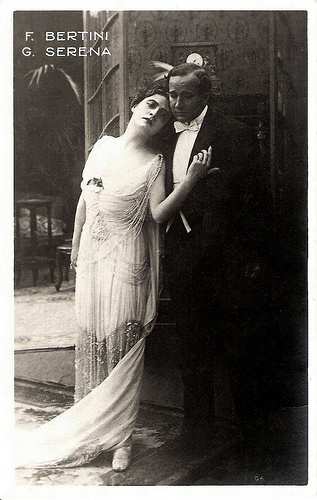
Italian postcard by Ed. Vettori, Bologna. Photo: still from La signora dalle camelie (1915) with Gustavo Serena .
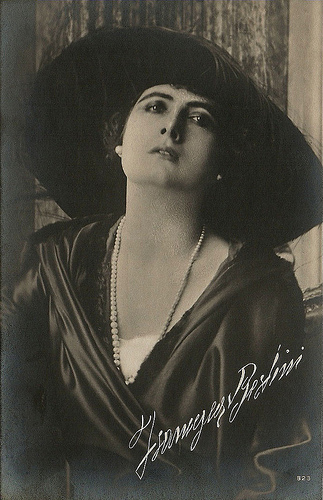
Italian postcard, no. 323. Collection: Didier Hanson.
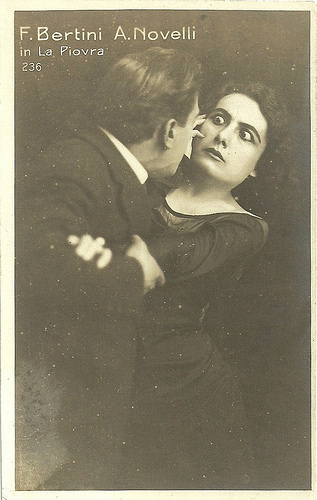
Italian postcard, no. 236. Photo: Francesca Bertini and Amleto Novelli in La piovra (Edoardo Bencivenga, 1919).

Italian postcard, no. 525. Photo: Francesca Bertini and Amleto Novelli in La piovra (Edoardo Bencivenga, 1919).
Suffering Demi-mondaine
Next Francesca Bertini played another of her best roles, Margherita Gauthier. La signora dalle camelie/The Lady of the Camelias (Gustavo Serena, 1915) was based on Alexandre Dumas fils' classic stage play La dame aux camélias, which again was the basis for Giuseppe Verdi's classic opera La traviata.
It's the tragic story of a tuberculosis-ridden, suffering demi-mondaine who wants to get rid of her past and settle down with her lover, but this is denied, first by society (his father) and then by fate (her own illness and premature death).
The drama inspired many actresses. In 1915, La dame aux camélias had already been filmed twice, first with Vittoria Lepanto (1909) and later by the great French actress Sarah Bernhardt (1911). In 1915, Bertini's rival Hesperia made a competing version of La signora dalle camelie (Baldassarre Negroni, 1915) and in the US Clara Kimball Young made another version (1915).
In the following decades versions followed with Theda Bara (1917), Erna Morena (1917), Pola Negri (1920), Alla Nazimova (1921), Sybil Thorndike (1922), Tora Teje (1925), Norma Talmadge (1926), Yvonne Printemps 1934), Greta Garbo (1936), Micheline Presle (1953), Maria Felix (1954), Sara Montiel (1962), Isabelle Huppert (1981), Teresa Stratas (1983), etc.
Bertini became popular internationally. Her sophistication emulated around the world by female filmgoers. Reputedly, she earned $175,000 in 1915 - a record for the time.
She developed the current acting techniques of film actresses by making it more sober, banning broad gestures or the mincing ways of the Diva. She is one of the first film actresses to focus on reality, rather than on a dramatic stereotype, an anticipation of Neorealistic canons. The expression of authentic feelings was the key of her success through many films. She could perform with success the languid decadent heroine as well as the popular common woman.
Among her most popular films were Ultimo sogno (Roberto Roberti, 1920) and La donna nuda (Roberto Roberti, 1922) opposite Angelo Ferrari . The director of these films, Roberto Roberti, was the father of spaghetti western genius Sergio Leone.
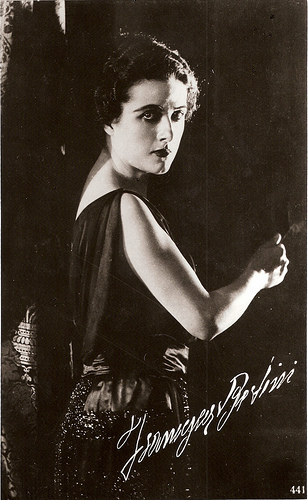
Italian postcard, no. 441.
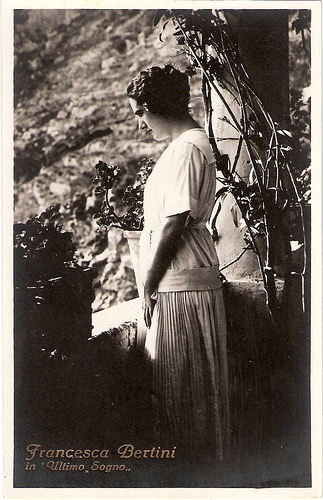
Italian postcard. Photo: still from Ultimo sogno (Roberto Roberti, 1920).

Italian postcard by G.B. Falci, Milano. Photo: publicity still for La giovinezza del diavolo/The youth of the devil (Roberto Roberti, 1922).

Italian postcard by Ed. G.B. Falci, Milano. Photo: publicity still of Francesca Bertini in Ultimo sogno (Roberto Roberti, 1921). The man could be the male protagonist, played by Mario Parpagnoli.
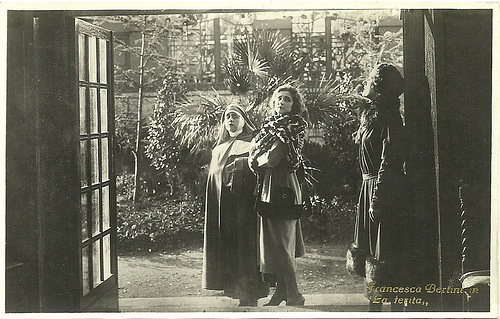
Italian postcard by Ed. G.B. Falci, Milano. Francesca Bertini in the Henry Kistemaeckers jr. adaptation La ferita (1920) by Roberto Roberti. While the film, originally entitled La blessure, was shot in 1920, it was only released in 1922 and hence - because of the new fascist regime - 'italianised' into La ferita. The woman right of the nun is Mary Fleuron, while Bertini is standing right. The two women are each other's rivals in the film.
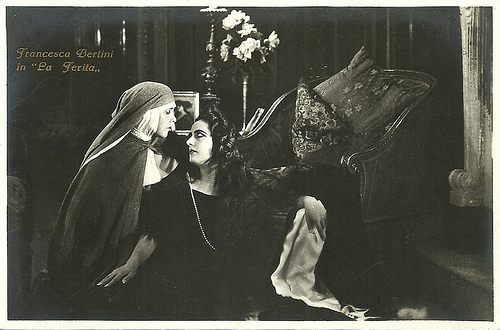
Italian postcard by G.B. Falci, Milano. Francesca Bertini in La ferita (Roberto Roberti, 1920).

Italian postcard by Ed. G.B. Falci, Milano. Francesca Bertini in the Henry Bataille adaptation La donna nuda (Caesar Film 1920), directed by Roberto Roberti. The man could be Franco Gennaro who plays the old painter Rouchard. After a suicide attempt over her persistently infidel lover, the painter Pierre Bernier ( Angelo Ferrari ), the model Lolette (Bertini) recovers in the hospital and decides to return to her old tutor Rouchard. The film was a remake of a film with Lyda Borelli, made in 1914 by Carmine Gallone.
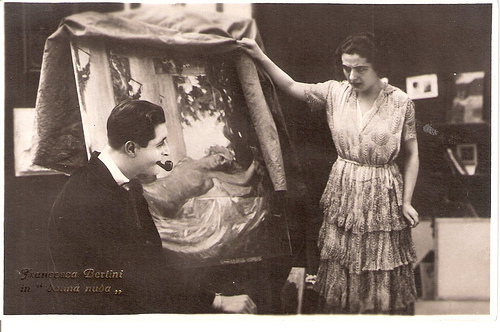
Italian postcard by G.B. Falci, Milano. Photo: still from La donna nuda (1922) with Angelo Ferrari .
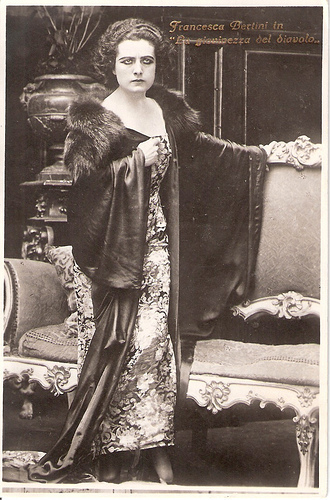
Italian postcard. Photo: still from La giovinezza del diavolo (1922).
Countess Bertini
La giovinezza del diavolo (Roberto Roberti, 1922) was a remake of the female Faustian tale of Rapsodia satanica (1917), starring another silent diva, Lyda Borelli . But by the 1920s, Borelli had retired from stage & screen, after a wealthy and aristocratic marriage, even if her films lingered on in the cinemas.
Director of La giovinezza del diavolo was Roberto Roberti, but the film bore its quality mark by the artistic supervision of Gabriellino D'Annunzio, the son of the famous poet, who just had filmed La nave, with D'Annunzio's mistress, dancer Ida Rubinstein. La giovinezza del diavolo had an unlucky life. It received its censorship card only two years after production and was finally released in 1925, when the diva trend was definitively over. Only Raimondo Van Riel received praise for his part as Mefistofeles.
In 1921 Bertini married count and banker Paul Cartier. After a decade of divadom she withdrew from filming. She moved to Paris, but when her husband died, she moved back to Rome, where she would remain until her death. In order to take care of her son, she returned to the film sets, and thus in the second half of the 1920s she made a comeback.
She acted in a handful of late silent Franco-German coproductions, opposite established actors such as Jean Angelo , Fritz Kortner and Rudolf Klein-Rogge : La fin de Monte Carlo/The End of Monte Carlo (Henri Étiévant, Mario Nalpas, 1926), Mein Leben für das Deine/Odette (Luitz-Morat, 1927), Tu m'appartiens/You Belong to Me (Maurice Gleize, 1928), and La possession (Léonce Perret, 1929).
She also acted in the multilinguals Königin einer Nacht/Queen for a Night (Marcel L'Herbier, 1930; also shot in a French and Italian version) and Odette (Jacques Houssin, Giorgio Zambon, 1934; shot in a French and an Italian version). The latter was the third version of Odette, based on a Stella Dallas-like tearjerker written by Victorien Sardou.
In 1914, Bertini had already performed in a Odette-like film, Sangue bleu, which narrative is close to that of Odette. In both versions she expressed the diep grief of a well-bred but fallen woman who loses her child because of a divorce. Years later, she is allowed to see her child once more, pretending to be a friend of the child's mother, and then she commits suicide.
Bertini continued to act with some regularity until 1930. From then on she made each decade one film. In 1976 Bernardo Bertolucci was able to convince her to emerge from her stubborn silence, accepting a role of a nun, sister Desolata, in Novecento/1900 (Bernardo Bertolucci, 1977). This was to be her last performance in a feature film.
In 1982 she was the subject of the documentary L'Ultima Diva/The Last Diva (1982), shot in her early 90s, she was as sharp and commanding as ever. She was also one of the Divas featured in Peter Delpeut's beautiful compilation film Diva Dolorosa (1999).
Francesca Bertini died in 1985 in Rome, at the age of 93.
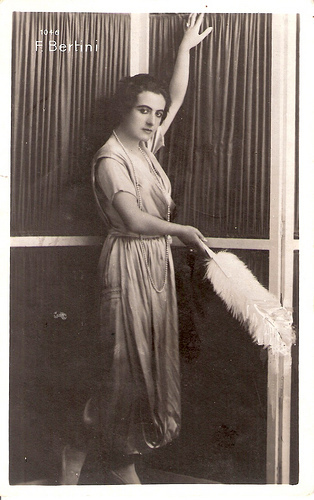
Italian postcard by Ed. Vettori, Bologna, no. 1046.
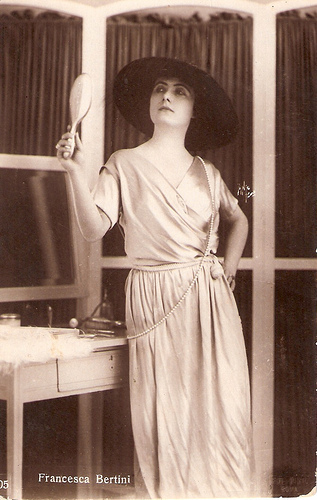
Italian postcard by Ed. A. Traldi, Milano.
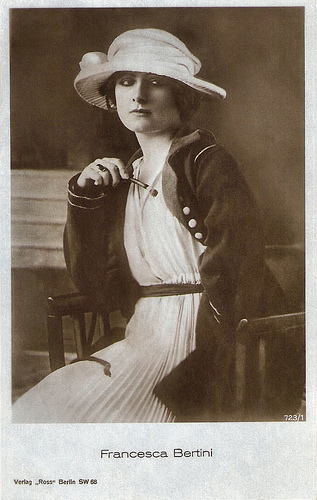
German postcard by Ross Verlag, Berlin, no. 723/1, 1925-1926.
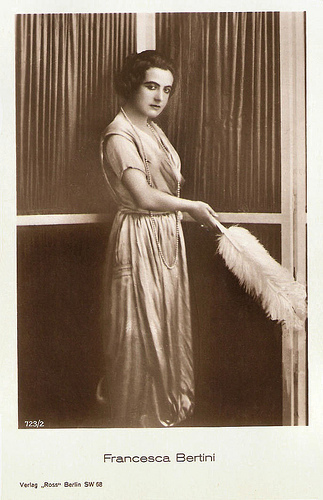
German postcard by Ross Verlag, Berlin, no. 723/2, 1925-1926.

German postcard by Ross Verlag, Berlin, no. 723/3, 1925-1926.

German postcard by Ross Verlag, Berlin, no. 723/5, 1925-1926.

French postcard by Editions Cinémagazine (EC), no. 2066. Photo: Studio Rudolph, Paris. Collection: Didier Hanson.

French postcard by Europe, no. 227. Photo: Sélections Cinégraphiques Maurice Rouhier. Jean Angelo and Francesca Bertini in the late silent film La fin de Monte-Carlo (Henri Etievant, Mario Nalpas, 1927). In this film, Bertini plays Cora, a woman who suspects Jacques (Angelo) to have killed her husband. Still, she falls in love with him and they live their romance in Monte-Carlo. When Cora's father is desperately in need of money, Jacques takes over of battleship and menaces to bomb Monte-Carlo if the casino doesn't give him money...

Italian postcard by S.A. Pittaluga, no. 341. Francesca Bertini and Fritz Kortner in Mein Leben für das Deine/My Life for Yours (Luitz-Morat, 1928), an adaptation of the play Odette by Victorien Sardou. Francesca Bertini played the part of Odette in three film versions: Odette (1916), Odette (1935), and this film.

Austrian postcard by Iris-Verlag, no. 5171. Photo: Verleih Philipps & Co.

French postcard: Editions Cinémagazine, Paris, no. 490. This card must be from Bertini's career in the late 1920s. In Mein Leben für das Deine (an incomplete copy was found at the former Netherlands Filmmuseum (now Eye Institute)) she holds the same enormous fan of ostrich feathers as the one on this postcard. Here Francesca Bertini is not the young star anymore, but what a glamorous light, what a dress and what a pose!
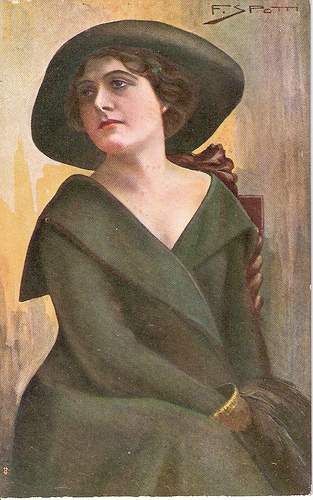
Watercolour by F. Spotti.
Sources: Gianfranco Mingozzi (Francesca Bertini), David Melville (IMDb), (IMDb), Greta de Groat (Unsung Divas of the Silent Screen), Wikipedia, and IMDb.

Italian postcard by Fotocelere, Torino, no. 324.

Vintage postcard by L.I.F.J.

Italian postcard by La Rotofotografica, no. 44. Photo: Unione Cinematografica Italiana, Roma.

Italian postcard by Ed. G. Vettori, Bologna, no. 244.

Italian postcard by Ed. G. Vettori, Bologna, no. 2029.

Czech postcard by Verlag Biografia, Kunstfilm G.m.b.H, Prag.

Italian postcard by Visto Censura, Torino, no. 6183-9-10-15.

Belgian postcard. Sent by mail in 1922.
Strong, Intense, and Charming Personality
Francesca Bertini was born Elena Seracini Vitiello in Firenze (Florence), Italy in 1892. She was the daughter of a comic theatre actress.
Bertini began performing on stages as a child, particularly in Naples, where her family was settled. In 1904, at the age of 16, she moved to Rome, where she improved her acting skills, especially on theatre stages, and attempted to perform in the just-born Italian cinema.
She made her film debut in La dea del mare (1907). She appeared in one-, two- and three-reelers for the Italian pioneering companies Cines and Celio. Gradually she developed her beauty and elegance, plus a strong, intense, and charming personality, which would be the key of her success as a silent film actress.
Her first important film was Histoire d'un pierrot/Pierrot the Prodigal (Baldassarre Negroni, 1914). Soon followed by appearances in L'amazzone mascherata/The Masked Amazon (Baldassarre Negroni, 1914), Sangue blu/Blue Blood (Nino Oxalia, 1914) and a small part in the successful historic epic Cabiria (Giovanni Pastrone, 1914).
Bertini was the most versatile of the big three Italian Divas - Bertini, Lyda Borelli , and Pina Menichelli . Her strong face and dignified suffering carried a large number of films, now mostly lost.
However, one of her most impressive films has survived: Assunta Spina (Francesca Bertini, Gustavo Serena, 1914). David Melville reviews on IMDb : "Assunta Spina is a work of dazzling dramatic intensity - with a heroine who is striking in her sensuality and modernity. Unlike the languid paper dolls who populate silent films by Griffith and others, Francesca Bertini plays a fully sexual woman. A vulnerable but hard-headed child of the slums, she's not above flirting with a man who's not her fiance, or - once the fiance goes to jail for attacking her in a jealous rage - prostituting herself to an official in order to save him. Not a Madonna, not a whore, but a woman. Perhaps the first real woman in screen history."
Bertini did not just play the role of the main character, but she also wrote the script, directed and produced the film. Later she directed herself again in one of her other famous roles, Tosca, in La Tosca (1918).

Italian postcard, no. 5560. Photo: Caesar Film, Roma. Collection: Didier Hanson.

Italian postcard by Cine-Excelsa. Photo: Officine foto-artistiche Sborgi, Firenze.

Italian postcard by G. Vettori, Bologna, no. 136.

Italian postcard by G. Vettori, Bologna, no. 290. Sent by mail in 1927.

Italian postcard, no. 382. Photo: probably a publicity still for Assunta Spina (1914).

Italian postcard by Ed. Vettori, Bologna. Photo: still from La signora dalle camelie (1915) with Gustavo Serena .

Italian postcard, no. 323. Collection: Didier Hanson.

Italian postcard, no. 236. Photo: Francesca Bertini and Amleto Novelli in La piovra (Edoardo Bencivenga, 1919).

Italian postcard, no. 525. Photo: Francesca Bertini and Amleto Novelli in La piovra (Edoardo Bencivenga, 1919).
Suffering Demi-mondaine
Next Francesca Bertini played another of her best roles, Margherita Gauthier. La signora dalle camelie/The Lady of the Camelias (Gustavo Serena, 1915) was based on Alexandre Dumas fils' classic stage play La dame aux camélias, which again was the basis for Giuseppe Verdi's classic opera La traviata.
It's the tragic story of a tuberculosis-ridden, suffering demi-mondaine who wants to get rid of her past and settle down with her lover, but this is denied, first by society (his father) and then by fate (her own illness and premature death).
The drama inspired many actresses. In 1915, La dame aux camélias had already been filmed twice, first with Vittoria Lepanto (1909) and later by the great French actress Sarah Bernhardt (1911). In 1915, Bertini's rival Hesperia made a competing version of La signora dalle camelie (Baldassarre Negroni, 1915) and in the US Clara Kimball Young made another version (1915).
In the following decades versions followed with Theda Bara (1917), Erna Morena (1917), Pola Negri (1920), Alla Nazimova (1921), Sybil Thorndike (1922), Tora Teje (1925), Norma Talmadge (1926), Yvonne Printemps 1934), Greta Garbo (1936), Micheline Presle (1953), Maria Felix (1954), Sara Montiel (1962), Isabelle Huppert (1981), Teresa Stratas (1983), etc.
Bertini became popular internationally. Her sophistication emulated around the world by female filmgoers. Reputedly, she earned $175,000 in 1915 - a record for the time.
She developed the current acting techniques of film actresses by making it more sober, banning broad gestures or the mincing ways of the Diva. She is one of the first film actresses to focus on reality, rather than on a dramatic stereotype, an anticipation of Neorealistic canons. The expression of authentic feelings was the key of her success through many films. She could perform with success the languid decadent heroine as well as the popular common woman.
Among her most popular films were Ultimo sogno (Roberto Roberti, 1920) and La donna nuda (Roberto Roberti, 1922) opposite Angelo Ferrari . The director of these films, Roberto Roberti, was the father of spaghetti western genius Sergio Leone.

Italian postcard, no. 441.

Italian postcard. Photo: still from Ultimo sogno (Roberto Roberti, 1920).

Italian postcard by G.B. Falci, Milano. Photo: publicity still for La giovinezza del diavolo/The youth of the devil (Roberto Roberti, 1922).

Italian postcard by Ed. G.B. Falci, Milano. Photo: publicity still of Francesca Bertini in Ultimo sogno (Roberto Roberti, 1921). The man could be the male protagonist, played by Mario Parpagnoli.

Italian postcard by Ed. G.B. Falci, Milano. Francesca Bertini in the Henry Kistemaeckers jr. adaptation La ferita (1920) by Roberto Roberti. While the film, originally entitled La blessure, was shot in 1920, it was only released in 1922 and hence - because of the new fascist regime - 'italianised' into La ferita. The woman right of the nun is Mary Fleuron, while Bertini is standing right. The two women are each other's rivals in the film.

Italian postcard by G.B. Falci, Milano. Francesca Bertini in La ferita (Roberto Roberti, 1920).

Italian postcard by Ed. G.B. Falci, Milano. Francesca Bertini in the Henry Bataille adaptation La donna nuda (Caesar Film 1920), directed by Roberto Roberti. The man could be Franco Gennaro who plays the old painter Rouchard. After a suicide attempt over her persistently infidel lover, the painter Pierre Bernier ( Angelo Ferrari ), the model Lolette (Bertini) recovers in the hospital and decides to return to her old tutor Rouchard. The film was a remake of a film with Lyda Borelli, made in 1914 by Carmine Gallone.

Italian postcard by G.B. Falci, Milano. Photo: still from La donna nuda (1922) with Angelo Ferrari .

Italian postcard. Photo: still from La giovinezza del diavolo (1922).
Countess Bertini
La giovinezza del diavolo (Roberto Roberti, 1922) was a remake of the female Faustian tale of Rapsodia satanica (1917), starring another silent diva, Lyda Borelli . But by the 1920s, Borelli had retired from stage & screen, after a wealthy and aristocratic marriage, even if her films lingered on in the cinemas.
Director of La giovinezza del diavolo was Roberto Roberti, but the film bore its quality mark by the artistic supervision of Gabriellino D'Annunzio, the son of the famous poet, who just had filmed La nave, with D'Annunzio's mistress, dancer Ida Rubinstein. La giovinezza del diavolo had an unlucky life. It received its censorship card only two years after production and was finally released in 1925, when the diva trend was definitively over. Only Raimondo Van Riel received praise for his part as Mefistofeles.
In 1921 Bertini married count and banker Paul Cartier. After a decade of divadom she withdrew from filming. She moved to Paris, but when her husband died, she moved back to Rome, where she would remain until her death. In order to take care of her son, she returned to the film sets, and thus in the second half of the 1920s she made a comeback.
She acted in a handful of late silent Franco-German coproductions, opposite established actors such as Jean Angelo , Fritz Kortner and Rudolf Klein-Rogge : La fin de Monte Carlo/The End of Monte Carlo (Henri Étiévant, Mario Nalpas, 1926), Mein Leben für das Deine/Odette (Luitz-Morat, 1927), Tu m'appartiens/You Belong to Me (Maurice Gleize, 1928), and La possession (Léonce Perret, 1929).
She also acted in the multilinguals Königin einer Nacht/Queen for a Night (Marcel L'Herbier, 1930; also shot in a French and Italian version) and Odette (Jacques Houssin, Giorgio Zambon, 1934; shot in a French and an Italian version). The latter was the third version of Odette, based on a Stella Dallas-like tearjerker written by Victorien Sardou.
In 1914, Bertini had already performed in a Odette-like film, Sangue bleu, which narrative is close to that of Odette. In both versions she expressed the diep grief of a well-bred but fallen woman who loses her child because of a divorce. Years later, she is allowed to see her child once more, pretending to be a friend of the child's mother, and then she commits suicide.
Bertini continued to act with some regularity until 1930. From then on she made each decade one film. In 1976 Bernardo Bertolucci was able to convince her to emerge from her stubborn silence, accepting a role of a nun, sister Desolata, in Novecento/1900 (Bernardo Bertolucci, 1977). This was to be her last performance in a feature film.
In 1982 she was the subject of the documentary L'Ultima Diva/The Last Diva (1982), shot in her early 90s, she was as sharp and commanding as ever. She was also one of the Divas featured in Peter Delpeut's beautiful compilation film Diva Dolorosa (1999).
Francesca Bertini died in 1985 in Rome, at the age of 93.

Italian postcard by Ed. Vettori, Bologna, no. 1046.

Italian postcard by Ed. A. Traldi, Milano.

German postcard by Ross Verlag, Berlin, no. 723/1, 1925-1926.

German postcard by Ross Verlag, Berlin, no. 723/2, 1925-1926.

German postcard by Ross Verlag, Berlin, no. 723/3, 1925-1926.

German postcard by Ross Verlag, Berlin, no. 723/5, 1925-1926.

French postcard by Editions Cinémagazine (EC), no. 2066. Photo: Studio Rudolph, Paris. Collection: Didier Hanson.

French postcard by Europe, no. 227. Photo: Sélections Cinégraphiques Maurice Rouhier. Jean Angelo and Francesca Bertini in the late silent film La fin de Monte-Carlo (Henri Etievant, Mario Nalpas, 1927). In this film, Bertini plays Cora, a woman who suspects Jacques (Angelo) to have killed her husband. Still, she falls in love with him and they live their romance in Monte-Carlo. When Cora's father is desperately in need of money, Jacques takes over of battleship and menaces to bomb Monte-Carlo if the casino doesn't give him money...

Italian postcard by S.A. Pittaluga, no. 341. Francesca Bertini and Fritz Kortner in Mein Leben für das Deine/My Life for Yours (Luitz-Morat, 1928), an adaptation of the play Odette by Victorien Sardou. Francesca Bertini played the part of Odette in three film versions: Odette (1916), Odette (1935), and this film.

Austrian postcard by Iris-Verlag, no. 5171. Photo: Verleih Philipps & Co.

French postcard: Editions Cinémagazine, Paris, no. 490. This card must be from Bertini's career in the late 1920s. In Mein Leben für das Deine (an incomplete copy was found at the former Netherlands Filmmuseum (now Eye Institute)) she holds the same enormous fan of ostrich feathers as the one on this postcard. Here Francesca Bertini is not the young star anymore, but what a glamorous light, what a dress and what a pose!

Watercolour by F. Spotti.
Sources: Gianfranco Mingozzi (Francesca Bertini), David Melville (IMDb), (IMDb), Greta de Groat (Unsung Divas of the Silent Screen), Wikipedia, and IMDb.
Published on July 03, 2014 23:00
July 2, 2014
Rosa Porten
Il Cinema Ritrovato 2014 has some interesting side programmes. One of these is focusing on Rosa Porten (1884-1972), the elder and lesser known sister of German silent film star Henny Porten. Both sisters started in 1906 as an actress for the pioneering Messter company and Rosa became one of the first women in Germany to write and direct films.
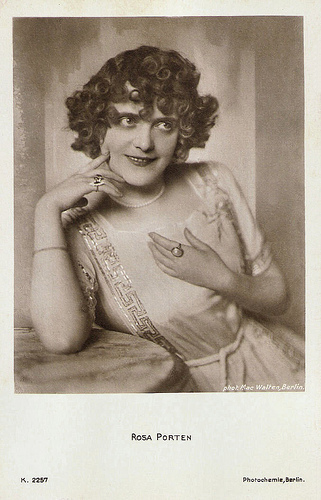
German postcard by Photochemie, no. K. 2257. Photo: Mac Walten, Berlin.
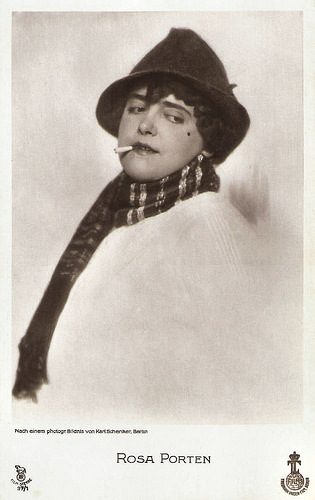
German postcard in the Film Sterne series by Rotophot, no. 97/1. Photo: Karl Schenker, Berlin / Treumann- Larsson Film, Berlin.
Writer-director
Rosa Porten was born in Düsseldorf, Germany, in 1884 (some sources say 1883 or 1889). She was the eldest daughter of opera baritone and later film director Franz Porten and his wife Vincenzia Porten-Wybiral. Her sister Henny Porten later became a legendary star of the German silent cinema.
As a child Rosa got singing and acting lessons from her father and appeared together with her sister at school performances. Just like for her sister, Rosa Porten' s first film performance was in the 'tonbild' (early sound film) Meissner Porzellan (1906) directed by their father for Messters Projektion GmbH.
The following years she appeared in more of these early sound pictures like Die kleine Baronesse/The Little Daughter of the Baron (1908) and Im Fasching/In the carnival (1908).
However, Rosa would be more active as a screenwriter than as an actress. She started this job with the Messter production Das Liebesglück der Blinden/The joy of love of the blind (Heinrich Bolten-Baeckers, Curt A. Stark, 1911), in which her sister Henny made her debut as leading lady opposite Friedrich Zelnik .
In the 1910's Rosa Porten was extremely active as a screenwriter for Messter and wrote such 20 minutes films as Das große Schweigen/The Great Silence (Rudolf Biebrach, 1915) starring her sister Henny.
For the Treumann-Larsen company she and her husband Franz Eckstein wrote many scripts under the pseudonym of Dr. R. Portegg and they also directed these films. In some films of these films she even played the female lead too, such as in Die Wäscher-Resl (1916), the comedy Die Erzkokette (1917) with Reinhold Schünzel , the fast paced comedy Die Landpommeranze/The Unwieldy Country Woman (1917), Die Augen der Schwester/The Eyes of the Sister (1918), and Themis (1918).
In other examples of these Treumann-Larsen productions like Das Opfer der Yella Rogesius/The Sacrifice of Yella Rogesius (1917) and Wanda's Trick (1918), actress Wanda Treumann played the lead.
Probably the last film which the couple Eckstein-Porten directed together was Der nicht vom Weibe geborene (Franz Eckstein, Rosa Porten, 1918), starring Conrad Veidt as Satan.
Tosa Porten also wrote such novels as Filmprinzeß (Film Princess), Androgyne and Die neue Generation (The New Generation).
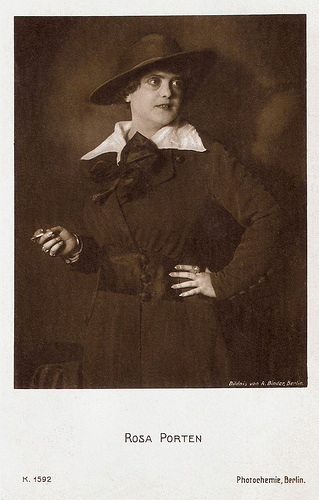
German postcard by Photochemie, Berlin, no. K 1592. Photo: Alex Binder, Berlin.
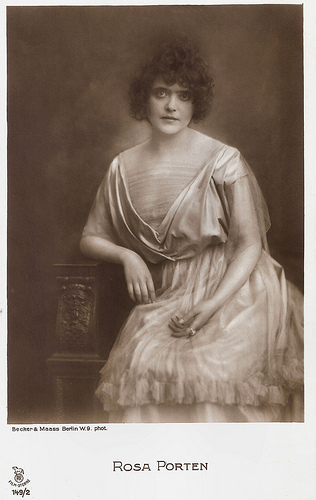
German postcard in the Film-Sterne series by Rotophot, no. 149/2. Photo: Becker & Maass.
Scriptwriter
In the 1920's Rosa Porten and Franz Eckstein went to work for the National-Film AG in Berlin, but with Porten only as screenwriter and with Eckstein only as director.
Examples of their films are Lotte Lore (1921) and Hedda Gabler (1924), starring Asta Nielsen .
Mid-1920s Eckstein and Porten stopped at National Film, but they did three more films: Das Mädchen aus der Fremde/The Foreign Girl (1926/27), Fahrendes Volk/Wandering performers (1927), and Die Heiratsfalle/The marriage case (1928).
She stopped working as an actress. From 1931 to 1945 Rosa Porten lived happily in Pommern with Eckstein.
Her husband died two months before the Russians and Poles invaded Pommern, forcing her to flee and ending up in Munich, where she wrote for newspapers, radio and cinema.
She had a small part in the Italo-German coproduction Land der Sehnsucht/Land of Longing (Erich Engel, Camillo Mastrocinque, 1950), which was never finished.
Rosa Porten died in Munich in 1972.
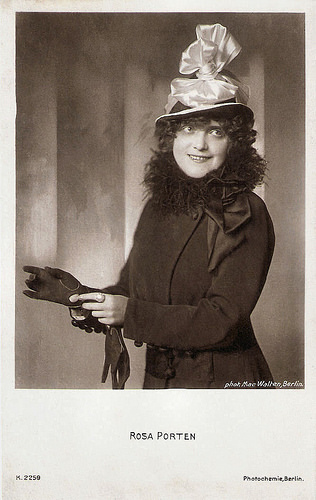
German postcard by Photochemie, no. K. 2259. Photo: Mac Walten, Berlin.
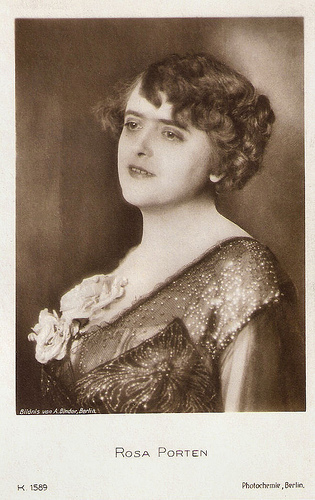
German postcard by Photochemie, Berlin, no. K 1589. Photo: Alex Binder, Berlin.
Source: Gabriele Hansch, Gerlinde Waz (Filmportal.de) (German), Thomas Staedeli (Cyranos), Wikipedia (German) and .

German postcard by Photochemie, no. K. 2257. Photo: Mac Walten, Berlin.

German postcard in the Film Sterne series by Rotophot, no. 97/1. Photo: Karl Schenker, Berlin / Treumann- Larsson Film, Berlin.
Writer-director
Rosa Porten was born in Düsseldorf, Germany, in 1884 (some sources say 1883 or 1889). She was the eldest daughter of opera baritone and later film director Franz Porten and his wife Vincenzia Porten-Wybiral. Her sister Henny Porten later became a legendary star of the German silent cinema.
As a child Rosa got singing and acting lessons from her father and appeared together with her sister at school performances. Just like for her sister, Rosa Porten' s first film performance was in the 'tonbild' (early sound film) Meissner Porzellan (1906) directed by their father for Messters Projektion GmbH.
The following years she appeared in more of these early sound pictures like Die kleine Baronesse/The Little Daughter of the Baron (1908) and Im Fasching/In the carnival (1908).
However, Rosa would be more active as a screenwriter than as an actress. She started this job with the Messter production Das Liebesglück der Blinden/The joy of love of the blind (Heinrich Bolten-Baeckers, Curt A. Stark, 1911), in which her sister Henny made her debut as leading lady opposite Friedrich Zelnik .
In the 1910's Rosa Porten was extremely active as a screenwriter for Messter and wrote such 20 minutes films as Das große Schweigen/The Great Silence (Rudolf Biebrach, 1915) starring her sister Henny.
For the Treumann-Larsen company she and her husband Franz Eckstein wrote many scripts under the pseudonym of Dr. R. Portegg and they also directed these films. In some films of these films she even played the female lead too, such as in Die Wäscher-Resl (1916), the comedy Die Erzkokette (1917) with Reinhold Schünzel , the fast paced comedy Die Landpommeranze/The Unwieldy Country Woman (1917), Die Augen der Schwester/The Eyes of the Sister (1918), and Themis (1918).
In other examples of these Treumann-Larsen productions like Das Opfer der Yella Rogesius/The Sacrifice of Yella Rogesius (1917) and Wanda's Trick (1918), actress Wanda Treumann played the lead.
Probably the last film which the couple Eckstein-Porten directed together was Der nicht vom Weibe geborene (Franz Eckstein, Rosa Porten, 1918), starring Conrad Veidt as Satan.
Tosa Porten also wrote such novels as Filmprinzeß (Film Princess), Androgyne and Die neue Generation (The New Generation).

German postcard by Photochemie, Berlin, no. K 1592. Photo: Alex Binder, Berlin.

German postcard in the Film-Sterne series by Rotophot, no. 149/2. Photo: Becker & Maass.
Scriptwriter
In the 1920's Rosa Porten and Franz Eckstein went to work for the National-Film AG in Berlin, but with Porten only as screenwriter and with Eckstein only as director.
Examples of their films are Lotte Lore (1921) and Hedda Gabler (1924), starring Asta Nielsen .
Mid-1920s Eckstein and Porten stopped at National Film, but they did three more films: Das Mädchen aus der Fremde/The Foreign Girl (1926/27), Fahrendes Volk/Wandering performers (1927), and Die Heiratsfalle/The marriage case (1928).
She stopped working as an actress. From 1931 to 1945 Rosa Porten lived happily in Pommern with Eckstein.
Her husband died two months before the Russians and Poles invaded Pommern, forcing her to flee and ending up in Munich, where she wrote for newspapers, radio and cinema.
She had a small part in the Italo-German coproduction Land der Sehnsucht/Land of Longing (Erich Engel, Camillo Mastrocinque, 1950), which was never finished.
Rosa Porten died in Munich in 1972.

German postcard by Photochemie, no. K. 2259. Photo: Mac Walten, Berlin.

German postcard by Photochemie, Berlin, no. K 1589. Photo: Alex Binder, Berlin.
Source: Gabriele Hansch, Gerlinde Waz (Filmportal.de) (German), Thomas Staedeli (Cyranos), Wikipedia (German) and .
Published on July 02, 2014 23:00
July 1, 2014
Erich von Stroheim
Il Cinema Ritrovato film festival
(28 June - 5 July) in Bologna celebrates the 50th anniversary of Österreichisches Filmmuseum with a screening of the silent classic The Merry Widow (Erich von Stroheim, 1925) with Mae Murray and John Gilbert. As the sadistic, monocled Prussian officer in both American and French films, Austrian-born Erich von Stroheim (1885–1957) became ‘The Man You Love to Hate’. But maybe he is best known as one of the greatest and influential directors of the silent era, known for his extravaganza and the uncompromising accuracy of detail in his monumental films.
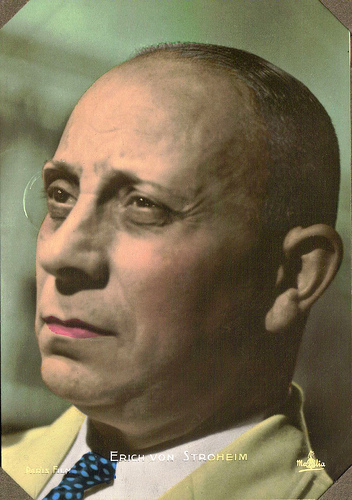 French card by Massilia. Photo: Paris Film. Collection: Amit Benyovits.
French card by Massilia. Photo: Paris Film. Collection: Amit Benyovits.
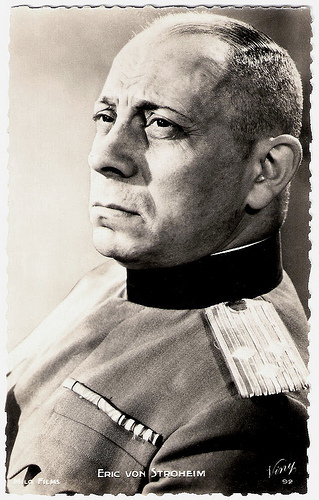 French postcard by Viny, no. 92. Photo: Milo Films. Collection: Didier Hanson.
French postcard by Viny, no. 92. Photo: Milo Films. Collection: Didier Hanson.
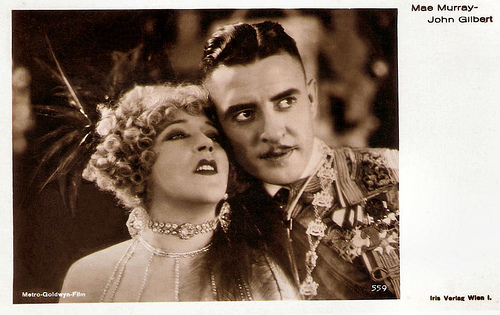
Austrian postcard by Iris Verlag, no. 559. Photo: Metro-Goldwyn-Film. Publicity still for The Merry Widow (Erich von Stroheim, 1925) with Mae Murray and John Gilbert.
Deep Depressions And Terrible Temper Tantrums
Erich von Stroheim's most recent biographers, such as Richard Koszarski, say that he was born in Austria-Hungary (now Austria) in 1885 as Erich Oswald Stroheim.
He was the son of Benno Stroheim, a middle-class hat-maker, and Johanna Bondy, both of whom were practicing Jews. Stroheim emigrated to America at the end of 1909. On arrival at Ellis Island he claimed to be Count Erich Oswald Hans Carl Maria von Stroheim und Nordenwall, the son of Austrian nobility like the characters he later played in his films. However, both Billy Wilder and Stroheim's agent Paul Kohner claimed that he spoke with a decidedly lower-class Austrian accent.
In 1912 while working at a tavern he met his first wife, Margaret Knox, and moved in with her. Knox acted as a sort of mentor to Von Stroheim, teaching him language and literature and encouraging him to write. Under Knox's tutelage, he wrote a novella entitled In the Morning, with themes that anticipated his films: corrupt aristocracy and innocence debased. The couple married in 1913, but money woes drove von Stroheim to deep depressions and terrible temper tantrums, and in 1914 Knox filed for divorce.
By then Von Stroheim was working in Hollywood. He began his cinema career in bit-parts and as a consultant on German culture and fashion. His first film was The Country Boy (Frederick A. Thomson, 1915) in which he was an uncredited diner in a restaurant.
His first credited role came in Old Heidelberg (John Emerson, 1915) starring Wallace Reed and Dorothy Gish. He began working with D. W. Griffith, taking uncredited roles in Intolerance (1916). Additionally, Von Stroheim acted as one of the many assistant directors on Intolerance, a film remembered in part for its huge cast of extras.
Later, he played the sneering German with the short Prussian military hairstyle in such films as Sylvia of the Secret Service (George Fitzmaurice, 1917) and The Hun Within (Chester Whitey, 1918) with Dorothy Gish.
In the war drama The Heart of Humanity (Allen Holubar, 1918), he tore the buttons from a nurse's uniform with his teeth, and when disturbed by a crying baby, threw it out of a window. Following the end of World War I, Von Stroheim turned to writing.
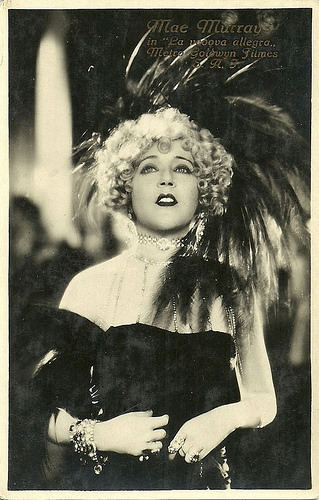
Italian postcard by G.B. Falci, Milano. Photo: Metro-Goldwyn-Film. Mae Murray in The Merry Widow (Erich von Stroheim, 1925).
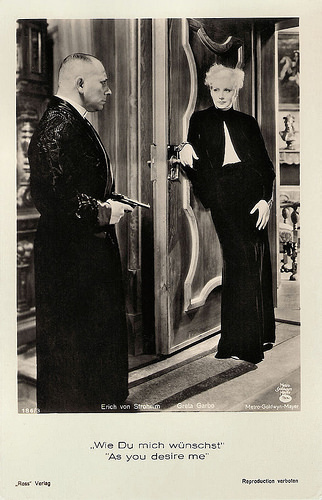
German postcard by Ross Verlag, no. 186/3. Photo: Metro-Goldwyn-Mayer. Publicity still for As You Desire me (George Fitzmaurice, 1932) with Erich von Stroheim and Greta Garbo .
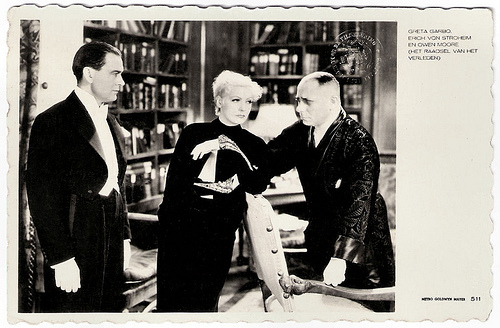
Dutch postcard, no. 511. Photo: Metro-Goldwyn-Mayer. Publicity still for As You Desire me (George Fitzmaurice, 1932)with Owen Moore, Greta Garbo and Erich von Stroheim.
A Dictatorial And Demanding Director
In 1919, Erich von Strohem directed his own script for Blind Husbands (1919), and also starred in the film. As a director, Stroheim was known to be dictatorial and demanding, often antagonizing his actors. He is considered one of the greatest directors of the silent era, with his both cynical and romantic views of human nature.
His next directorial efforts were the lost film The Devil's Pass Key (1919) and Foolish Wives (1922), in which he also starred. Studio publicity for Foolish Wives claimed that it was the first film to cost one million dollars. ‘Von’ translated sexual subjects in a witty and ostentatious manner, and his first films for Universal are among the most acclaimed sophisticated films of the silent era.
In 1923, Von Stroheim began work on Merry-Go-Round. He cast the American actor Norman Kerry in a part written for himself, 'Count Franz Maximilian Von Hohenegg', and newcomer Mary Philbin in the lead actress role. However studio executive Irving Thalberg fired Von Stroheim during filming and replaced him with director Rupert Julian.
He left Universal for Goldwyn Films to make Greed (1924). This monumental film is now one of Von Stroheim's best remembered works as a director. It is a detailed filming of Frank Norris’ novel McTeague, about the power of money to corrupt. The original print ran for an astonishing 10 hours. Knowing this version was far too long, Stroheim cut out almost half the footage, reducing it to a six-hour version to be shown over two nights. It was still deemed too long, so Von Stroheim and director Rex Ingram edited it into a four-hour version that could be shown in two parts.
In the midst of filming, Goldwyn was bought by Marcus Loew and merged into Metro-Goldwyn-Mayer. After rejecting Von Stroheim's attempts to cut it to less than three hours, MGM removed Greed from his control and gave it to head scriptwriter June Mathis, with orders to cut it down to a manageable length. Mathis gave the print to a routine cutter, who reduced it to 2.5 hours. In what is considered one of the greatest losses in cinema history, a janitor destroyed the cut footage. The shortened release version was a box-office failure, and was angrily disowned by Von Stroheim.
Von Stroheim followed with his most commercially successful film The Merry Widow (1925) starring Mae Murray and John Gilbert, the more personal The Wedding March (1928) and the low-lost The Honeymoon (1928). Stroheim's unwillingness or inability to modify his artistic principles for the commercial cinema, his extreme attention to detail, his insistence on near-total artistic freedom and the resulting costs of his films led to fights with the studios.
As time went on he received fewer directing opportunities. In 1929, Von Stroheim was dismissed as the director of the film Queen Kelly after disagreements with star Gloria Swanson and producer and financier Joseph P. Kennedy over the mounting costs of the film and Von Stroheim's introduction of indecent subject matter into the film's scenario. It was followed by Walking Down Broadway, another project from which Von Stroheim was dismissed.
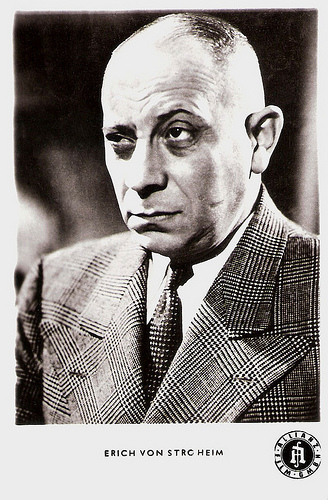 German postcard by Netter's Star Verlag, Berlin. Photo: Allianz Film GmbH.
German postcard by Netter's Star Verlag, Berlin. Photo: Allianz Film GmbH.
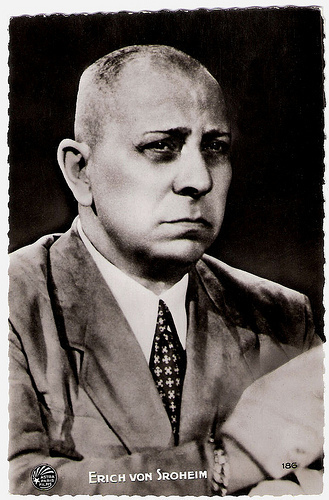 French postcard by Edition P.I., Paris, no. 186. Photo: Astra Paris Films.
French postcard by Edition P.I., Paris, no. 186. Photo: Astra Paris Films.
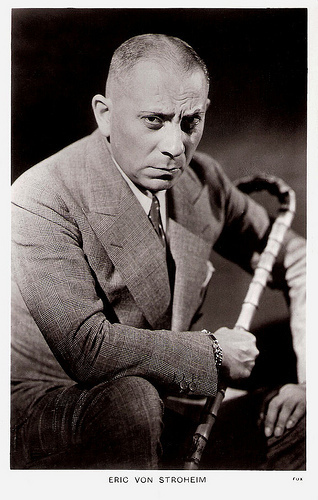 British postcard by Real Photograph, London, in the Picturegoer series, no. 20a. Photo: Fox.
British postcard by Real Photograph, London, in the Picturegoer series, no. 20a. Photo: Fox.
Friendship, Comradeship And Human Relations
After the introduction of sound film, Erich von Stroheim returned to working principally as an actor, in both American and French films.
One of his most famous roles is the prison-camp commandant Von Rauffenstein in Jean Renoir's La Grande Illusion/Grand Illusion (1937) with Jean Gabin . It is a classic anti-war film about friendship, comradeship, and human relations.
Working in France on the eve of World War II, Stroheim was prepared to direct the film La dame blanche from his own story and screenplay. Jean Renoir wrote the dialogue, Jacques Becker was to be assistant director and Von Stroheim himself, Louis Jouvet and Jean-Louis Barrault were to be the featured actors. The production was prevented by the outbreak of the war on 1 September 1939, and Stroheim returned to the United States.
There he appeared in Five Graves to Cairo (Billy Wilder, 1943). Today, he is perhaps best known as an actor for his role as Max von Mayerling in Wilder's Sunset Boulevard (Billy Wilder, 1950), co-starring Gloria Swanson. For this role, Von Stroheim was nominated for the Academy Award for Best Supporting Actor. His character states in the film that he used to be one of the three great directors of the silent era, along with D.W. Griffith and Cecil B. DeMille, and he and Swanson watch excerpts from Queen Kelly in the film. Their characters in Sunset Boulevard thus had an autobiographical basis and reflected the humiliations Von Stroheim suffered through his career.
Erich von Stroheim was married three times. His second wife was Mae Jones. Their son Erich Jr. became an assistant director. With his third wife, actress Valerie Germonprez, he had another son, Joseph Erich von Stroheim, who eventually became a sound editor. From 1939 until his death, he lived with actress Denise Vernac. She had worked for him as his secretary since 1938, and co-starred with him in several films.
Von Stroheim spent the last part of his life in France where his silent film work was much admired by artists in the French film industry. In France he acted in films, wrote several novels that were published in French, and worked on various unrealized film projects. Erich von Stroheim was awarded the Légion d'honneur shortly before his death in 1957 in Maurepas near Paris, France at the age of 71.
Erich von Stroheim is smoking in Foolish Wives (1922) to the tune of Leo Riesman's Smoke Gets In Your Eyes. Source: gregoryagogo (YouTube).
Trailer La Grande Illusion/Grand Illusion (1937). Source: Danios12345 (YouTube).
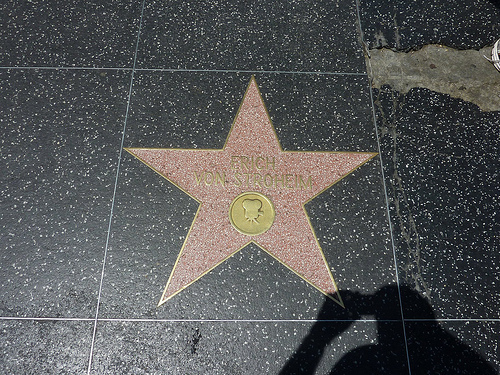
Walk of Fame, Hollywood.
Sources: Bruce Eder (AllMovie), Encyclopaedia Britannica, Wikipedia and .
 French card by Massilia. Photo: Paris Film. Collection: Amit Benyovits.
French card by Massilia. Photo: Paris Film. Collection: Amit Benyovits. French postcard by Viny, no. 92. Photo: Milo Films. Collection: Didier Hanson.
French postcard by Viny, no. 92. Photo: Milo Films. Collection: Didier Hanson.
Austrian postcard by Iris Verlag, no. 559. Photo: Metro-Goldwyn-Film. Publicity still for The Merry Widow (Erich von Stroheim, 1925) with Mae Murray and John Gilbert.
Deep Depressions And Terrible Temper Tantrums
Erich von Stroheim's most recent biographers, such as Richard Koszarski, say that he was born in Austria-Hungary (now Austria) in 1885 as Erich Oswald Stroheim.
He was the son of Benno Stroheim, a middle-class hat-maker, and Johanna Bondy, both of whom were practicing Jews. Stroheim emigrated to America at the end of 1909. On arrival at Ellis Island he claimed to be Count Erich Oswald Hans Carl Maria von Stroheim und Nordenwall, the son of Austrian nobility like the characters he later played in his films. However, both Billy Wilder and Stroheim's agent Paul Kohner claimed that he spoke with a decidedly lower-class Austrian accent.
In 1912 while working at a tavern he met his first wife, Margaret Knox, and moved in with her. Knox acted as a sort of mentor to Von Stroheim, teaching him language and literature and encouraging him to write. Under Knox's tutelage, he wrote a novella entitled In the Morning, with themes that anticipated his films: corrupt aristocracy and innocence debased. The couple married in 1913, but money woes drove von Stroheim to deep depressions and terrible temper tantrums, and in 1914 Knox filed for divorce.
By then Von Stroheim was working in Hollywood. He began his cinema career in bit-parts and as a consultant on German culture and fashion. His first film was The Country Boy (Frederick A. Thomson, 1915) in which he was an uncredited diner in a restaurant.
His first credited role came in Old Heidelberg (John Emerson, 1915) starring Wallace Reed and Dorothy Gish. He began working with D. W. Griffith, taking uncredited roles in Intolerance (1916). Additionally, Von Stroheim acted as one of the many assistant directors on Intolerance, a film remembered in part for its huge cast of extras.
Later, he played the sneering German with the short Prussian military hairstyle in such films as Sylvia of the Secret Service (George Fitzmaurice, 1917) and The Hun Within (Chester Whitey, 1918) with Dorothy Gish.
In the war drama The Heart of Humanity (Allen Holubar, 1918), he tore the buttons from a nurse's uniform with his teeth, and when disturbed by a crying baby, threw it out of a window. Following the end of World War I, Von Stroheim turned to writing.

Italian postcard by G.B. Falci, Milano. Photo: Metro-Goldwyn-Film. Mae Murray in The Merry Widow (Erich von Stroheim, 1925).

German postcard by Ross Verlag, no. 186/3. Photo: Metro-Goldwyn-Mayer. Publicity still for As You Desire me (George Fitzmaurice, 1932) with Erich von Stroheim and Greta Garbo .

Dutch postcard, no. 511. Photo: Metro-Goldwyn-Mayer. Publicity still for As You Desire me (George Fitzmaurice, 1932)with Owen Moore, Greta Garbo and Erich von Stroheim.
A Dictatorial And Demanding Director
In 1919, Erich von Strohem directed his own script for Blind Husbands (1919), and also starred in the film. As a director, Stroheim was known to be dictatorial and demanding, often antagonizing his actors. He is considered one of the greatest directors of the silent era, with his both cynical and romantic views of human nature.
His next directorial efforts were the lost film The Devil's Pass Key (1919) and Foolish Wives (1922), in which he also starred. Studio publicity for Foolish Wives claimed that it was the first film to cost one million dollars. ‘Von’ translated sexual subjects in a witty and ostentatious manner, and his first films for Universal are among the most acclaimed sophisticated films of the silent era.
In 1923, Von Stroheim began work on Merry-Go-Round. He cast the American actor Norman Kerry in a part written for himself, 'Count Franz Maximilian Von Hohenegg', and newcomer Mary Philbin in the lead actress role. However studio executive Irving Thalberg fired Von Stroheim during filming and replaced him with director Rupert Julian.
He left Universal for Goldwyn Films to make Greed (1924). This monumental film is now one of Von Stroheim's best remembered works as a director. It is a detailed filming of Frank Norris’ novel McTeague, about the power of money to corrupt. The original print ran for an astonishing 10 hours. Knowing this version was far too long, Stroheim cut out almost half the footage, reducing it to a six-hour version to be shown over two nights. It was still deemed too long, so Von Stroheim and director Rex Ingram edited it into a four-hour version that could be shown in two parts.
In the midst of filming, Goldwyn was bought by Marcus Loew and merged into Metro-Goldwyn-Mayer. After rejecting Von Stroheim's attempts to cut it to less than three hours, MGM removed Greed from his control and gave it to head scriptwriter June Mathis, with orders to cut it down to a manageable length. Mathis gave the print to a routine cutter, who reduced it to 2.5 hours. In what is considered one of the greatest losses in cinema history, a janitor destroyed the cut footage. The shortened release version was a box-office failure, and was angrily disowned by Von Stroheim.
Von Stroheim followed with his most commercially successful film The Merry Widow (1925) starring Mae Murray and John Gilbert, the more personal The Wedding March (1928) and the low-lost The Honeymoon (1928). Stroheim's unwillingness or inability to modify his artistic principles for the commercial cinema, his extreme attention to detail, his insistence on near-total artistic freedom and the resulting costs of his films led to fights with the studios.
As time went on he received fewer directing opportunities. In 1929, Von Stroheim was dismissed as the director of the film Queen Kelly after disagreements with star Gloria Swanson and producer and financier Joseph P. Kennedy over the mounting costs of the film and Von Stroheim's introduction of indecent subject matter into the film's scenario. It was followed by Walking Down Broadway, another project from which Von Stroheim was dismissed.
 German postcard by Netter's Star Verlag, Berlin. Photo: Allianz Film GmbH.
German postcard by Netter's Star Verlag, Berlin. Photo: Allianz Film GmbH. French postcard by Edition P.I., Paris, no. 186. Photo: Astra Paris Films.
French postcard by Edition P.I., Paris, no. 186. Photo: Astra Paris Films. British postcard by Real Photograph, London, in the Picturegoer series, no. 20a. Photo: Fox.
British postcard by Real Photograph, London, in the Picturegoer series, no. 20a. Photo: Fox.Friendship, Comradeship And Human Relations
After the introduction of sound film, Erich von Stroheim returned to working principally as an actor, in both American and French films.
One of his most famous roles is the prison-camp commandant Von Rauffenstein in Jean Renoir's La Grande Illusion/Grand Illusion (1937) with Jean Gabin . It is a classic anti-war film about friendship, comradeship, and human relations.
Working in France on the eve of World War II, Stroheim was prepared to direct the film La dame blanche from his own story and screenplay. Jean Renoir wrote the dialogue, Jacques Becker was to be assistant director and Von Stroheim himself, Louis Jouvet and Jean-Louis Barrault were to be the featured actors. The production was prevented by the outbreak of the war on 1 September 1939, and Stroheim returned to the United States.
There he appeared in Five Graves to Cairo (Billy Wilder, 1943). Today, he is perhaps best known as an actor for his role as Max von Mayerling in Wilder's Sunset Boulevard (Billy Wilder, 1950), co-starring Gloria Swanson. For this role, Von Stroheim was nominated for the Academy Award for Best Supporting Actor. His character states in the film that he used to be one of the three great directors of the silent era, along with D.W. Griffith and Cecil B. DeMille, and he and Swanson watch excerpts from Queen Kelly in the film. Their characters in Sunset Boulevard thus had an autobiographical basis and reflected the humiliations Von Stroheim suffered through his career.
Erich von Stroheim was married three times. His second wife was Mae Jones. Their son Erich Jr. became an assistant director. With his third wife, actress Valerie Germonprez, he had another son, Joseph Erich von Stroheim, who eventually became a sound editor. From 1939 until his death, he lived with actress Denise Vernac. She had worked for him as his secretary since 1938, and co-starred with him in several films.
Von Stroheim spent the last part of his life in France where his silent film work was much admired by artists in the French film industry. In France he acted in films, wrote several novels that were published in French, and worked on various unrealized film projects. Erich von Stroheim was awarded the Légion d'honneur shortly before his death in 1957 in Maurepas near Paris, France at the age of 71.
Erich von Stroheim is smoking in Foolish Wives (1922) to the tune of Leo Riesman's Smoke Gets In Your Eyes. Source: gregoryagogo (YouTube).
Trailer La Grande Illusion/Grand Illusion (1937). Source: Danios12345 (YouTube).

Walk of Fame, Hollywood.
Sources: Bruce Eder (AllMovie), Encyclopaedia Britannica, Wikipedia and .
Published on July 01, 2014 23:00
June 30, 2014
Eduardo De Filippo
We're in Bologna, Italy visiting Il Cinema Ritrovato film festival (28 June - 5 July). One of the sections is 'Italian Episodes 1952-1968. The 1950s and 1960s were the golden age of Italian comedy and also a period in which the irregular structure of the episodic or anthology film imposed itself. Many of the episodes are flashes of genius that stay in the memory thanks to their short form, economic rhetoric and striking directness. One of the titles is Cova delle uova from Eduardo De Filippo's Marito e moglie (1952). Napolitan actor-director De Filippo was also a playwright, screenwriter, author and poet, best known for his plays Filumena Marturano and Napoli Milionaria. He began to direct films in 1940. During the 1950s, he turned out a string of successful light comedies, many based on his own plays. In addition to writing and directing his own films, he also wrote or collaborated on films with such directors as Vittorio De Sica.
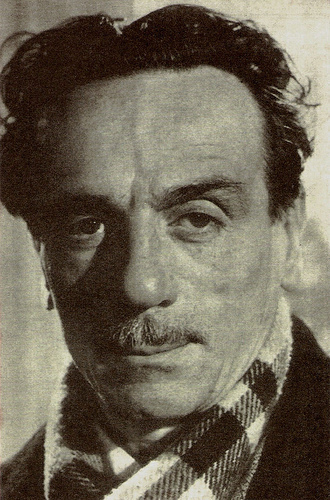
Italian postcard.
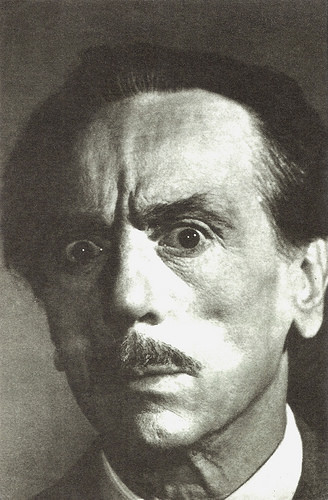
Italian postcard.
Do not pay!
Eduardo De Filippo was born in Naples, Italy in 1900. He was the illegitimate son of actor/playwright Eduardo Scarpetta and theatre seamstress/costumier Luisa De Filippo. His sister was actress Titina De Filippo and his brother actor/writer Peppino De Filippo.
Eduardo began acting at the age of four or five, the sources differ. According to Italica , the website of Rai International, he made his debut in 1904 as a Japanese child in La geisha (The Geisha), written by his father. The next year, he was Peppiniello in his father's comedy Miseria e Nobiltà (Poverty and Nobility).
In 1914 he joined the regular staff of his step-brother Eduardo Scarpetta's theatre company, where he stayed until 1920 when he was called up for military service. In 1922, on completing his military service, he resumed his acting career in the theatre.
Like his father, he also started to write for the stage. Among his early plays are Farmacia di turno (The All-night Chemist, 1920), Uomo e galantuomo (Man and Gentleman, 1922), Requie a l'anema soja/I morti non fanno paura (May his soul rest, 1926) and Filosoficamente (Philosophically, 1928).
In the early 1930s he wrote Ogni anno punto e da capo (Every Year Back from the Start, 1931), È arrivato 'o trentuno (The 31st is Here, 1931), Natale in casa Cupiello (Christmas at the Cupiello's, 1931) and La voce del padrone/Il successo del giorno (Success of the Day, 1932).
In 1932 he formed a theatre company with his brother Peppino and sister Titina, called compagnia del Teatro Umoristico I De Filippo.
From 1933 they also appeared in films. In the French-Italian comedy Tre uomini in frack/Three Lucky Fools (Mario Bonnard, 1933), Eduardo co-starred with opera tenor Tito Schipa and French actor Fred Pasquali.
It was followed by Il cappello a tre punte/Three Cornered Hat (Mario Camerini, 1934) and Quei due (Gennaro Righelli, 1935). He started to directed the comedies he starred in, like In campagna è caduta una stella/In the Country Fell a Star (Eduardo De Filippo, 1939).
With Titina and Peppino De Filippo, he played in the comedy Non ti pago!/Do not pay! (Carlo Ludovico Bragaglia, 1942), which he also co-wrote. The trio enjoyed success in both mediums, but broke up soon after World War II ended.
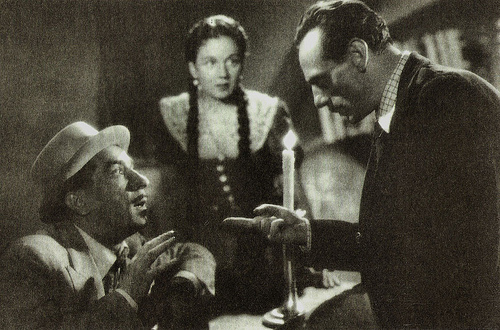
Italian postcard. Photo: publicity still of Casanova farebbe così/Casanova Would Do It That Way! (Carlo Ludovico Bragaglia, 1942) with Peppino and Eduardo de Filippo and Clelia Matania.
Life Begins Anew
Eduardo De Filippo founded the Compagnia di Eduardo, which in 1946 staged Questi fantasmi (Ghosts - Italian Style), followed by the hugely successful Filumena Marturano, which was to become the most famous role of his sister Titina.
Other plays were Napoli milionaria (The Millions of Naples, 1945), Le voci di dentro (Inner Voices, 1948), Mia famiglia (Family of Mine, 1955) and Sabato, domenica e lunedì (Saturday, Sunday and Monday, 1959).
In the cinema he appeared with Alida Valli and Fosco Giachetti in the drama La vita ricomincia/Life Begins Anew (Mario Mattoli. 1945). It was the second most popular Italian film of the year after Roberto Rossellini's Paisan.
He also appeared in dramas like Assunta Spina/Scarred (Mario Mattoli, 1948) starring Anna Magnani , but De Filippo is better known for his comedies like Napoli milionaria/The Millions of Naples (Eduardo De Filippo, 1950) based on his own play, Filumena Marturano (Eduardo De Filippo, 1951) featuring Titiana and the anthology film L'oro di Napoli/The Gold of Naples ( Vittorio De Sica , 1954). In a segment with Tina Pica he played ‘professor’ Ersilio Micci, a ‘wisdom seller’ solving problems.
Filomena Maurano was filmed again as Matrimonio all'italiana/Marriage Italian Style ( Vittorio De Sica , 1964) starring Sophia Loren and Marcello Mastroianni .
One of De Filippo’s most successful films as a director was Fortunella/Happy-go-lucky Girl (Eduardo De Filippo, 1958) featuring Giulietta Massina . Other interesting films are L'amore più bello/The Most Beautiful Love (Glauco Pellegrini, 1958) with Alida Valli and child star Edoardo Nevola, the war drama Tutti a casa/ Everybody Go Home (Luigi Comencini, 1960) with Alberto Sordi, and the fantasy Fantasmi a Roma/Ghosts of Rome (Antonio Pietrangeli, 1961) starring Marcello Mastroianni.
Later het mostly appeared on television. In 1973 his play Sabato, domenica e lunedi (1959, Saturday, Sunday and Monday), was put on at the Old Vic theatre in London. The production directed by Franco Zeffirelli and starring Laurence Olivier , won the London drama critics' award.
In 1981, Eduardo De Filippo was appointed life senator of the Italian Republic. He died four years later in Rome at the age of 84.
His last screen appearance was in the TV mini-series Cuore/Heart (Luigi Comencini, 1984) with Johnny Dorelli.
De Filippo was married three or maybe four times: to Vanna Polverosi (?), Dorothy Pennington (1928-1956), Thea Prandi (1956-1959), with whom he had two children, and to Isabella Quarantotti (1977-1984). His artistic legacy has been carried over by his son, Luca De Filippo.
His plays are often used for TV films, such as Filumena Marturano (Franza Di Rosa, 2010) featuring Mariangela Melato and Sabato, domenica e lunedì/Saturday, Sunday and Monday (Franza Di Rosa, 2012) with Massimo Ranieri.
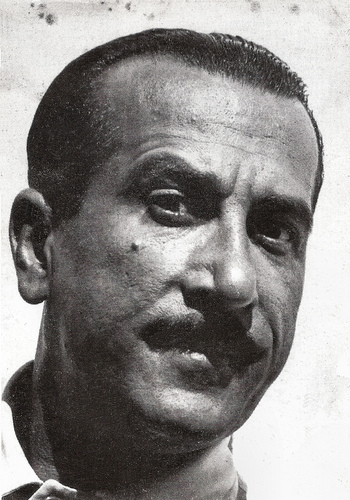
Peppino De Filippo. Italian postcard in the series Gli Artisti di Napoli.
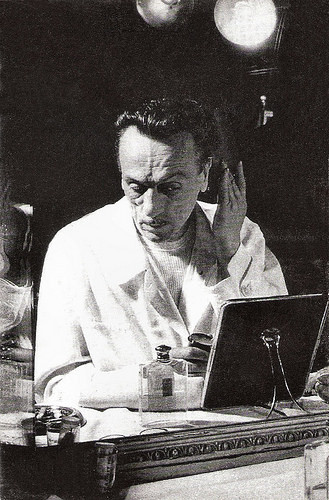
Italian postcard in the series Gli Artisti di Napoli.
Sources: (IMDb), Italica, Wikipedia and

Italian postcard.

Italian postcard.
Do not pay!
Eduardo De Filippo was born in Naples, Italy in 1900. He was the illegitimate son of actor/playwright Eduardo Scarpetta and theatre seamstress/costumier Luisa De Filippo. His sister was actress Titina De Filippo and his brother actor/writer Peppino De Filippo.
Eduardo began acting at the age of four or five, the sources differ. According to Italica , the website of Rai International, he made his debut in 1904 as a Japanese child in La geisha (The Geisha), written by his father. The next year, he was Peppiniello in his father's comedy Miseria e Nobiltà (Poverty and Nobility).
In 1914 he joined the regular staff of his step-brother Eduardo Scarpetta's theatre company, where he stayed until 1920 when he was called up for military service. In 1922, on completing his military service, he resumed his acting career in the theatre.
Like his father, he also started to write for the stage. Among his early plays are Farmacia di turno (The All-night Chemist, 1920), Uomo e galantuomo (Man and Gentleman, 1922), Requie a l'anema soja/I morti non fanno paura (May his soul rest, 1926) and Filosoficamente (Philosophically, 1928).
In the early 1930s he wrote Ogni anno punto e da capo (Every Year Back from the Start, 1931), È arrivato 'o trentuno (The 31st is Here, 1931), Natale in casa Cupiello (Christmas at the Cupiello's, 1931) and La voce del padrone/Il successo del giorno (Success of the Day, 1932).
In 1932 he formed a theatre company with his brother Peppino and sister Titina, called compagnia del Teatro Umoristico I De Filippo.
From 1933 they also appeared in films. In the French-Italian comedy Tre uomini in frack/Three Lucky Fools (Mario Bonnard, 1933), Eduardo co-starred with opera tenor Tito Schipa and French actor Fred Pasquali.
It was followed by Il cappello a tre punte/Three Cornered Hat (Mario Camerini, 1934) and Quei due (Gennaro Righelli, 1935). He started to directed the comedies he starred in, like In campagna è caduta una stella/In the Country Fell a Star (Eduardo De Filippo, 1939).
With Titina and Peppino De Filippo, he played in the comedy Non ti pago!/Do not pay! (Carlo Ludovico Bragaglia, 1942), which he also co-wrote. The trio enjoyed success in both mediums, but broke up soon after World War II ended.

Italian postcard. Photo: publicity still of Casanova farebbe così/Casanova Would Do It That Way! (Carlo Ludovico Bragaglia, 1942) with Peppino and Eduardo de Filippo and Clelia Matania.
Life Begins Anew
Eduardo De Filippo founded the Compagnia di Eduardo, which in 1946 staged Questi fantasmi (Ghosts - Italian Style), followed by the hugely successful Filumena Marturano, which was to become the most famous role of his sister Titina.
Other plays were Napoli milionaria (The Millions of Naples, 1945), Le voci di dentro (Inner Voices, 1948), Mia famiglia (Family of Mine, 1955) and Sabato, domenica e lunedì (Saturday, Sunday and Monday, 1959).
In the cinema he appeared with Alida Valli and Fosco Giachetti in the drama La vita ricomincia/Life Begins Anew (Mario Mattoli. 1945). It was the second most popular Italian film of the year after Roberto Rossellini's Paisan.
He also appeared in dramas like Assunta Spina/Scarred (Mario Mattoli, 1948) starring Anna Magnani , but De Filippo is better known for his comedies like Napoli milionaria/The Millions of Naples (Eduardo De Filippo, 1950) based on his own play, Filumena Marturano (Eduardo De Filippo, 1951) featuring Titiana and the anthology film L'oro di Napoli/The Gold of Naples ( Vittorio De Sica , 1954). In a segment with Tina Pica he played ‘professor’ Ersilio Micci, a ‘wisdom seller’ solving problems.
Filomena Maurano was filmed again as Matrimonio all'italiana/Marriage Italian Style ( Vittorio De Sica , 1964) starring Sophia Loren and Marcello Mastroianni .
One of De Filippo’s most successful films as a director was Fortunella/Happy-go-lucky Girl (Eduardo De Filippo, 1958) featuring Giulietta Massina . Other interesting films are L'amore più bello/The Most Beautiful Love (Glauco Pellegrini, 1958) with Alida Valli and child star Edoardo Nevola, the war drama Tutti a casa/ Everybody Go Home (Luigi Comencini, 1960) with Alberto Sordi, and the fantasy Fantasmi a Roma/Ghosts of Rome (Antonio Pietrangeli, 1961) starring Marcello Mastroianni.
Later het mostly appeared on television. In 1973 his play Sabato, domenica e lunedi (1959, Saturday, Sunday and Monday), was put on at the Old Vic theatre in London. The production directed by Franco Zeffirelli and starring Laurence Olivier , won the London drama critics' award.
In 1981, Eduardo De Filippo was appointed life senator of the Italian Republic. He died four years later in Rome at the age of 84.
His last screen appearance was in the TV mini-series Cuore/Heart (Luigi Comencini, 1984) with Johnny Dorelli.
De Filippo was married three or maybe four times: to Vanna Polverosi (?), Dorothy Pennington (1928-1956), Thea Prandi (1956-1959), with whom he had two children, and to Isabella Quarantotti (1977-1984). His artistic legacy has been carried over by his son, Luca De Filippo.
His plays are often used for TV films, such as Filumena Marturano (Franza Di Rosa, 2010) featuring Mariangela Melato and Sabato, domenica e lunedì/Saturday, Sunday and Monday (Franza Di Rosa, 2012) with Massimo Ranieri.

Peppino De Filippo. Italian postcard in the series Gli Artisti di Napoli.

Italian postcard in the series Gli Artisti di Napoli.
Sources: (IMDb), Italica, Wikipedia and
Published on June 30, 2014 23:00
June 29, 2014
Gianna Maria Canale
We're in Bologna, Italy visiting Il Cinema Ritrovato film festival (28 June - 5 July). One of the sections, we're following is Freda: a Master of Popular Cinema. Director Riccardo Freda (1909-1999) always consciously worked in popular genres, taking inspiration from classic literature and silent film. He was the author of some of the greatest successes of the post-war period, but was only discovered thanks to the French critics of the 1960s, and is since revered by generations of film lovers and filmmakers. Star of many of his spectacles was his wife, the Italian femme fatale Gianna Maria Canale (1927-2009). Her anatomy figured prominently in the sword-and-sandal epics and pirate adventures in which she played sultry temptresses or princesses in distress. La Canale was also a leading lady of international films of the 1950s and early 1960s.
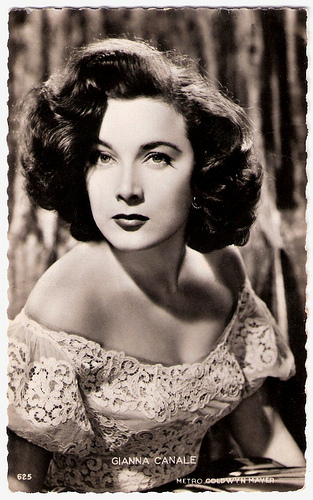
French postcard by Editions P.I., Paris, no. 625, 1953. Photo: MGM (Metro Goldwyn Mayer).
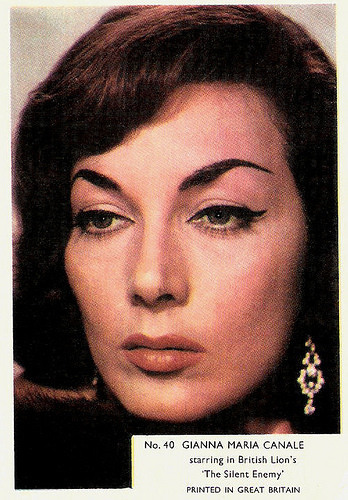
British collectors card, no. 40. Publicity still for The Silent Enemy (William Fairchild, 1958).
Miss Calabria
Gianna Maria Canale was born of Greek descent in Reggio Calabria, in the south of Italy, in 1927.
When she was working as a steno typist, her film career started with a small role in the film Aquila Nera/Return of the Black Eagle (Riccardo Freda, 1946) starring Rossano Brazzi .
The next year she entered as Miss Calabria the now legendary Miss Italia 1947 contest. Lucia Bosè became Miss Italia, but Canale placed second before three other gorgeous, future film stars, Gina Lollobrigida , Eleonora Rossi-Drago and Silvana Mangano .
After the beauty contest Canale received publicity in many Italian magazines who compared her sultry, dark-haired looks to those of Ava Gardner. Egyptian born director Riccardo Freda (aka Robert Hampton), who had directed her in Aquila Nera, offered her a film contract and a role opposite Vittorio Gassman in Il cavaliere misterioso/The Mysterious Cavalier (Riccardo Freda, 1948).
In this film she had a nude scene. During the shooting the director and his leading lady fell in love. Freda left his wife and he and Canale got married in Brazil. There they shot two films, Guarany (Riccardo Freda, 1948) and O Caçula do Barulho (Riccardo Freda, 1949).
Canale could not get used to the South American climate and they returned to Italy. There she was often directed by her husband in such films as Il conte Ugolino/Count Ugolino (Riccardo Freda, 1949) with Carlo Ninchi, Il figlio di d'Artagnan/The Son of d’Artagnan (Riccardo Freda, 1950) again with Ninchi, and Vedi Napoli e poi muori/See Naples and Die (Riccardo Freda, 1951).
In their Black Eagle sequel La vendetta di Aquila Nera/The Revenge of the Black Eagle (Riccardo Freda, 1951) she was now the leading lady opposite Rossano Brazzi .
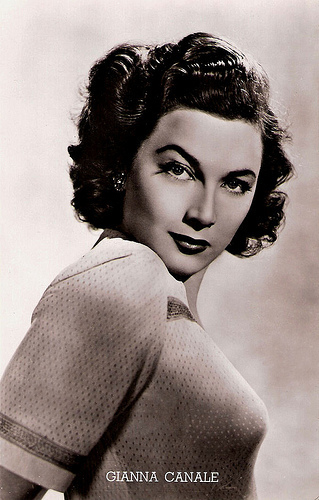
French postcard. Photo: MGM (Metro Goldwyn Mayer).
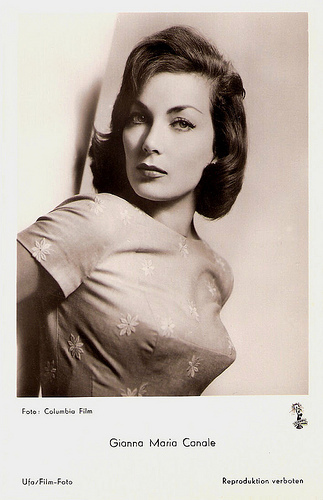
German postcard by Ufa (Universum-Film Aktiengesellschaft), Berlin-Tempelhof, nr. FK 4259. Ratil price 25 Pfg. Photo: Columbia Film. publicity still for The Whole Truth (John Guillermin, 1958).
Queen of the Peplum
In 1951, Gianna Maria Canale played a supporting role in the American war film Go for Broke! (Robert Pirosh, 1951) starring Van Johnson. The director, Robert Pirosh, wrote his own script, a tribute to Japanese-American volunteers fighting in World War II.
Canale continued to appear in Italian films, but she also starred in such international films as the film noir Dramma nella Kasbah/The Man From Cairo (Ray Enright, 1953) starring George Raft, Madame du Barry (Christian-Jaque, 1954) with Martine Carol , and Napoléon (Sacha Guitry, 1955).
In Italy she starred in many Peplums or Sandaloni - sword and sandal films - including the first Hercules film Le fatiche di Ercole/Hercules (Pietro Francisi, 1958) which featured her as the Queen of the Amazons opposite bodybuilder Steve Reeves.
At AllMovie , critic Hal Erickson calls her “A practioner of the ‘enigmatic femme fatale’ school of screen performing (...) Most of Canale's film appearances were exotic to the point of self-mockery”, as witness Teodora, imperatrice di Bisanzio/Theodora Slave Empress (Riccardo Freda, 1954) and La Venere dei pirati/Queen of the Pirates (Mario Costa, 1961).
I vampiri/Evil's Commandment (1956) was her last film with Freda, and during the shooting they separated. I vampiri, the first Italian horror film of the sound era, was completed by future Italian fantasy specialist Mario Bava. In this stylish and elegant fantasy she plays Duchess Giselle du Grand who is kept alive with blood experiments.
Canale continued to appear in international films, including the biopic The Silent Enemy (William Fairchild, 1958) with Laurence Harvey as the controversial British war hero Lionel Crabb, and the thriller The Whole Truth (John Guillermin, 1958) as a temperamental Italian film star/murdered mistress of Stewart Granger .
One of the most interesting of her later films was Il boom (Vittorio de Sica, 1963), a somber comedy with Alberto Sordi that was sadly overlooked.
Gianna Maria Canale retired from the film industry in 1964. What happened then with her? Most of our sources only indicate that she became the widow of Riccardo Freda in 1999 and that Canale herself died in Florence in 2009, aged 81.
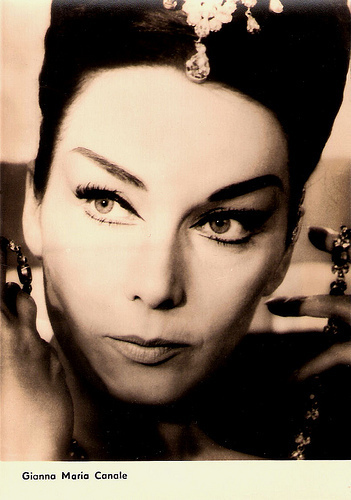
East-German postcard by VEB Progress Film-Vertrieb, Berlin, no. 2916, 1967. Retail price: MDN 0,20. Photo: Progress. Publicity still for Le chevalier de Pardaillan/Clash of Steel (Bernard Borderie, 1962).
La Diva. A Tribute by Orazio Garofalo. Source: oraziogarofalorende (YouTube).
Sources: Hal Erickson (AllMovie), Glamour Girls of the Silver Screen, Wikipedia and .

French postcard by Editions P.I., Paris, no. 625, 1953. Photo: MGM (Metro Goldwyn Mayer).

British collectors card, no. 40. Publicity still for The Silent Enemy (William Fairchild, 1958).
Miss Calabria
Gianna Maria Canale was born of Greek descent in Reggio Calabria, in the south of Italy, in 1927.
When she was working as a steno typist, her film career started with a small role in the film Aquila Nera/Return of the Black Eagle (Riccardo Freda, 1946) starring Rossano Brazzi .
The next year she entered as Miss Calabria the now legendary Miss Italia 1947 contest. Lucia Bosè became Miss Italia, but Canale placed second before three other gorgeous, future film stars, Gina Lollobrigida , Eleonora Rossi-Drago and Silvana Mangano .
After the beauty contest Canale received publicity in many Italian magazines who compared her sultry, dark-haired looks to those of Ava Gardner. Egyptian born director Riccardo Freda (aka Robert Hampton), who had directed her in Aquila Nera, offered her a film contract and a role opposite Vittorio Gassman in Il cavaliere misterioso/The Mysterious Cavalier (Riccardo Freda, 1948).
In this film she had a nude scene. During the shooting the director and his leading lady fell in love. Freda left his wife and he and Canale got married in Brazil. There they shot two films, Guarany (Riccardo Freda, 1948) and O Caçula do Barulho (Riccardo Freda, 1949).
Canale could not get used to the South American climate and they returned to Italy. There she was often directed by her husband in such films as Il conte Ugolino/Count Ugolino (Riccardo Freda, 1949) with Carlo Ninchi, Il figlio di d'Artagnan/The Son of d’Artagnan (Riccardo Freda, 1950) again with Ninchi, and Vedi Napoli e poi muori/See Naples and Die (Riccardo Freda, 1951).
In their Black Eagle sequel La vendetta di Aquila Nera/The Revenge of the Black Eagle (Riccardo Freda, 1951) she was now the leading lady opposite Rossano Brazzi .

French postcard. Photo: MGM (Metro Goldwyn Mayer).

German postcard by Ufa (Universum-Film Aktiengesellschaft), Berlin-Tempelhof, nr. FK 4259. Ratil price 25 Pfg. Photo: Columbia Film. publicity still for The Whole Truth (John Guillermin, 1958).
Queen of the Peplum
In 1951, Gianna Maria Canale played a supporting role in the American war film Go for Broke! (Robert Pirosh, 1951) starring Van Johnson. The director, Robert Pirosh, wrote his own script, a tribute to Japanese-American volunteers fighting in World War II.
Canale continued to appear in Italian films, but she also starred in such international films as the film noir Dramma nella Kasbah/The Man From Cairo (Ray Enright, 1953) starring George Raft, Madame du Barry (Christian-Jaque, 1954) with Martine Carol , and Napoléon (Sacha Guitry, 1955).
In Italy she starred in many Peplums or Sandaloni - sword and sandal films - including the first Hercules film Le fatiche di Ercole/Hercules (Pietro Francisi, 1958) which featured her as the Queen of the Amazons opposite bodybuilder Steve Reeves.
At AllMovie , critic Hal Erickson calls her “A practioner of the ‘enigmatic femme fatale’ school of screen performing (...) Most of Canale's film appearances were exotic to the point of self-mockery”, as witness Teodora, imperatrice di Bisanzio/Theodora Slave Empress (Riccardo Freda, 1954) and La Venere dei pirati/Queen of the Pirates (Mario Costa, 1961).
I vampiri/Evil's Commandment (1956) was her last film with Freda, and during the shooting they separated. I vampiri, the first Italian horror film of the sound era, was completed by future Italian fantasy specialist Mario Bava. In this stylish and elegant fantasy she plays Duchess Giselle du Grand who is kept alive with blood experiments.
Canale continued to appear in international films, including the biopic The Silent Enemy (William Fairchild, 1958) with Laurence Harvey as the controversial British war hero Lionel Crabb, and the thriller The Whole Truth (John Guillermin, 1958) as a temperamental Italian film star/murdered mistress of Stewart Granger .
One of the most interesting of her later films was Il boom (Vittorio de Sica, 1963), a somber comedy with Alberto Sordi that was sadly overlooked.
Gianna Maria Canale retired from the film industry in 1964. What happened then with her? Most of our sources only indicate that she became the widow of Riccardo Freda in 1999 and that Canale herself died in Florence in 2009, aged 81.

East-German postcard by VEB Progress Film-Vertrieb, Berlin, no. 2916, 1967. Retail price: MDN 0,20. Photo: Progress. Publicity still for Le chevalier de Pardaillan/Clash of Steel (Bernard Borderie, 1962).
La Diva. A Tribute by Orazio Garofalo. Source: oraziogarofalorende (YouTube).
Sources: Hal Erickson (AllMovie), Glamour Girls of the Silver Screen, Wikipedia and .
Published on June 29, 2014 23:00
June 28, 2014
Zbigniew Cybulski
At the XXVIII edition of Il Cinema Ritrovato film festival in Bologna, Italy, there is a special section on Polish cinema and Cinemascope. Polish cinema came to international prominence with a cinematic movement that flourished during the 1950s and 1960s, and pressed a fresh and controversial vision of World War II which set in motion a sort of national therapy session. One of the renowned masterpieces is Rękopis znaleziony w Saragossie/The Saragossa Manuscript (Wojciech Has, 1965) – surrealism on epic scale starring the great Zbigniew Cybulski (1927-1967). With his trademark leather clothes and dark glasses, Cybulski is often referred to as ´the Polish James Dean´. He symbolized the angry feelings of young Poles trying to deal with their tumultuous post-WW II world. During his brief film career, he became one of the best-known and most versatile actors of the East-European cinema.
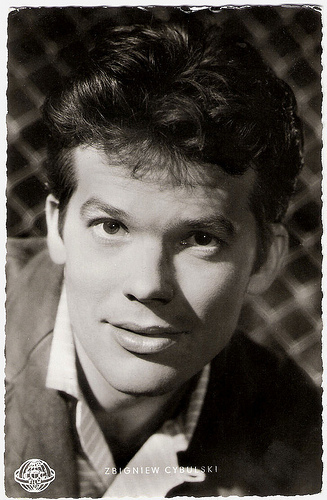
German postcard by Kunst und Bild, Berlin-Charlottenburg, no. S 758. Photo: CCC Film. Publicity still for Ósmy dzień tygodnia/The Eighth Day of the Week (Aleksander Ford, 1958).
The Young And Wrathful
In 1927, Zbigniew Hubert Cybulski was born in the small village of Kniaże near Stanisławów, Poland (now Ukraine). After World War II, ´Zbyszek´ joined the Theatre Academy in Kraków, where he graduated in 1953. He also studied journalism.
He moved to Gdańsk, where he made his stage debut in Leon Schiller's Wybrzeże Theatre. With his friend Bogumił Kobiela, Cybulski also founded the famous student theatre Bim-Bom.
In 1960, Cybulski moved to Warsaw, where he joined the Wagabunda experimental theatre. He also appeared on the stage of the Ateneum theatre, one of the most modern Warsaw-based theatres of the epoch. There he also worked as a director.
However, Zbigniew Cybulski is best remembered as a screen actor. He first appeared in Kariera/Career (Jan Koecher, 1954) as one of the extras (a bus passenger).
That year he also appeared as Kostek in Pokolenie/A Generation (Andrzej Wajda, 1955) starring Tadeusz Łomnicki and with the later director Roman Polanski in a supporting part. The film is based on the novel Pokolenie by Bohdan Czeszko, who also wrote the script.
Pokolenie was Wajda's first film and the opening installment of what became his Three War Films trilogy set in the Second World War. On its face, the film is a coming-of-age story of survival and shattering loss, delivering a brutal portrait of the human cost of war. But as with all of Wajda's films, Polish history and the individual's struggle in the face of crushing political circumstances are just below the surface.
In Pokolenie, as later in Popiół i diament/Ashes and Diamonds, the communists and the nationalist Home Army, each representing a diametrically opposed view of Poland's future, are set on a collision course.
Cybulski´s first major roles came in the thriller Wraki/The Wrecks (Ewa Petelska, Czeslaw Petelski, 1957) and Krzyż Walecznych/Cross of Valor (Kazimierz Kutz, 1958).
Then he appeared as Resistance fighter Maciek Chelmicki, one of the main characters in Wajda's Popiół i diament/Ashes and Diamonds (Andrzej Wajda, 1958). This became his internationally most famous film. After the film's release, sales of sunglasses shot up because Cybulski wore them consistently throughout the film.
Ashes and Diamonds is based on the 1948 novel by Polish writer Jerzy Andrzejewski. It completed Wajda's war films trilogy, following Pokolenie/A Generation (1954) and Kanal/Canal (1956). The title comes from a 19th century poem by Cyprian Norwid and references the manner in which diamonds are formed from heat and pressure acting upon coal.
In 1958 Cybulski also played in Aleksander Ford's Ósmy dzień tygodnia/The Eighth Day of the Week (1958) based on a short story by Marek Hłasko. Since then, Cybulski was seen as one of the most notable actors of the Polish Film School and one of the ´young and wrathful´, as his generation of actors were called at the time. His style of acting was revolutionary at the time as was his image with his leather clothes and big sunglasses. Like James Dean, he played nonconformist rebels, and like him he died young.
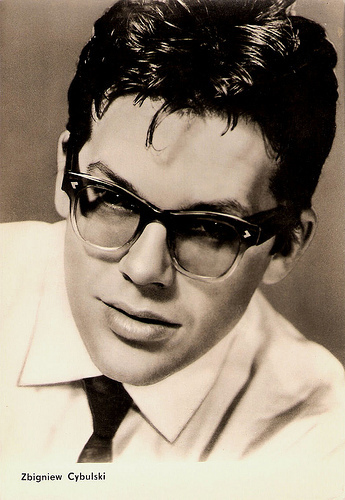
East-German postcard by VEB Progress Filmvertrieb, no. 2.164, 1964. Photo: Progress.
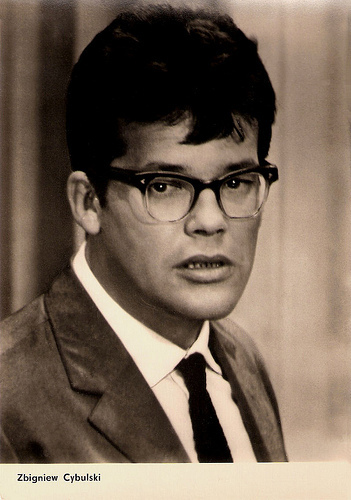
East-German postcard by VEB Progress Filmvertrieb, no. 1.969, 1964. Photo: Progress.
A Legend Of The Polish Cinema
Zbigniew Cybulski continued to work with Andrzej Wajda and appeared in Niewinni czarodzieje/Innocent Sorcerers (Andrzej Wajda, 1960), with Tadeusz Łomnicki and Roman Polanski.
Twice he worked on Western-European productions. He starred in the French-Italian science fiction film La poupée/He, She or It (Jacques Baratier, 1962), and also appeared in the French-produced omnibus project L'amour à vingt ans/Love at Twenty (1962) by Pierre Roustang, consisting of five segments directed by five directors from five different countries.
Cybulski starred in the fifth segment, directed by Andrzej Wajda and entitled Warszawa/Warsaw, considered as one of the best segments. It depicts a brief intergenerational liaison based upon multiple misunderstandings. The episodes are tied together with still photos by Henri Cartier-Bresson and a Jazz soundtrack by Georges Delerue. La Poupée and L'amour à vingt ans were both entered into the 12th Berlin International Film Festival.
Cybulski started his successful cooperation with director Wojciech Has with the films Rozstanie/Goodbye to the Past (1961) and Jak być kochaną/How to be Loved (1963).
Their best-known film is Rękopis znaleziony w Saragossie/The Saragossa Manuscript (Wojciech Has, 1965). The film was a relative success in Poland and other parts of communist eastern Europe upon its release, winning the Golden Wolf at the 1965 Bucharest Film Festival. It later also achieved a level of critical success in the United States, when filmmakers such as Martin Scorsese and Francis Ford Coppola rediscovered it and encouraged its propagation.
Another critical success was the film drama Salto/Jump (Tadeusz Konwicki, 1965) with Marta Lipinska. The film received an Honorary Diploma at the Edinburgh International Film Festival, 1967.
With Has he worked again on Szyfry/The Codes (Wojciech Has, 1966), about a father searching for his son, who has been missing since WW II.
He also appeared in numerous television plays, including ones based on works by Truman Capote, Anton Chekhov and Jerzy Andrzejewski.
Zbigniew Cybulski died in an accident at a Wrocław Główny railway station on 8 January 1967, on his way from the film set of Yowita/Yovita (Janusz Morgenstern, 1967) with Daniel Olbrychski . As he jumped for the already speeding train (as he had often done), he slipped on the steps, fell under the train, and was run over.
Before the accident he said goodbye to Marlene Dietrich , a personal friend of his, who was a passenger on the train. He was buried in Katowice.
The following year, Wajda made Wszystko na sprzedaz/Everything for Sale as a highly fictionalized tribute to Cybulski. In 1969 the Zbyszek Cybulski Award was introduced for young film actors with astrong individuality.
Cybulski remains a legend of the Polish cinema. In 1996, readers of Film magazine awarded him the title of Best Polish Actor of All Time. The Polish band 2 Plus 1 recorded a tribute album to Cybulski, called Aktor in 1977.
Zbigniew Cybulski was married to assistant director Elzbieta Chwalibóg (1960-1967). Their son Maciek (born in the early 1960s) was never interested in showbusiness and became an architect.
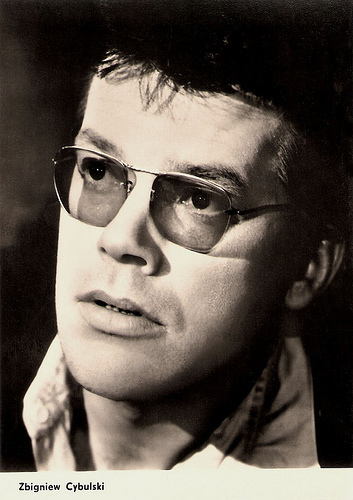
East-German postcard by VEB Progress Filmvertrieb, no. 1.938, 1963. Photo: Progress.
Sources: AllMovie, Wikipedia and

German postcard by Kunst und Bild, Berlin-Charlottenburg, no. S 758. Photo: CCC Film. Publicity still for Ósmy dzień tygodnia/The Eighth Day of the Week (Aleksander Ford, 1958).
The Young And Wrathful
In 1927, Zbigniew Hubert Cybulski was born in the small village of Kniaże near Stanisławów, Poland (now Ukraine). After World War II, ´Zbyszek´ joined the Theatre Academy in Kraków, where he graduated in 1953. He also studied journalism.
He moved to Gdańsk, where he made his stage debut in Leon Schiller's Wybrzeże Theatre. With his friend Bogumił Kobiela, Cybulski also founded the famous student theatre Bim-Bom.
In 1960, Cybulski moved to Warsaw, where he joined the Wagabunda experimental theatre. He also appeared on the stage of the Ateneum theatre, one of the most modern Warsaw-based theatres of the epoch. There he also worked as a director.
However, Zbigniew Cybulski is best remembered as a screen actor. He first appeared in Kariera/Career (Jan Koecher, 1954) as one of the extras (a bus passenger).
That year he also appeared as Kostek in Pokolenie/A Generation (Andrzej Wajda, 1955) starring Tadeusz Łomnicki and with the later director Roman Polanski in a supporting part. The film is based on the novel Pokolenie by Bohdan Czeszko, who also wrote the script.
Pokolenie was Wajda's first film and the opening installment of what became his Three War Films trilogy set in the Second World War. On its face, the film is a coming-of-age story of survival and shattering loss, delivering a brutal portrait of the human cost of war. But as with all of Wajda's films, Polish history and the individual's struggle in the face of crushing political circumstances are just below the surface.
In Pokolenie, as later in Popiół i diament/Ashes and Diamonds, the communists and the nationalist Home Army, each representing a diametrically opposed view of Poland's future, are set on a collision course.
Cybulski´s first major roles came in the thriller Wraki/The Wrecks (Ewa Petelska, Czeslaw Petelski, 1957) and Krzyż Walecznych/Cross of Valor (Kazimierz Kutz, 1958).
Then he appeared as Resistance fighter Maciek Chelmicki, one of the main characters in Wajda's Popiół i diament/Ashes and Diamonds (Andrzej Wajda, 1958). This became his internationally most famous film. After the film's release, sales of sunglasses shot up because Cybulski wore them consistently throughout the film.
Ashes and Diamonds is based on the 1948 novel by Polish writer Jerzy Andrzejewski. It completed Wajda's war films trilogy, following Pokolenie/A Generation (1954) and Kanal/Canal (1956). The title comes from a 19th century poem by Cyprian Norwid and references the manner in which diamonds are formed from heat and pressure acting upon coal.
In 1958 Cybulski also played in Aleksander Ford's Ósmy dzień tygodnia/The Eighth Day of the Week (1958) based on a short story by Marek Hłasko. Since then, Cybulski was seen as one of the most notable actors of the Polish Film School and one of the ´young and wrathful´, as his generation of actors were called at the time. His style of acting was revolutionary at the time as was his image with his leather clothes and big sunglasses. Like James Dean, he played nonconformist rebels, and like him he died young.

East-German postcard by VEB Progress Filmvertrieb, no. 2.164, 1964. Photo: Progress.

East-German postcard by VEB Progress Filmvertrieb, no. 1.969, 1964. Photo: Progress.
A Legend Of The Polish Cinema
Zbigniew Cybulski continued to work with Andrzej Wajda and appeared in Niewinni czarodzieje/Innocent Sorcerers (Andrzej Wajda, 1960), with Tadeusz Łomnicki and Roman Polanski.
Twice he worked on Western-European productions. He starred in the French-Italian science fiction film La poupée/He, She or It (Jacques Baratier, 1962), and also appeared in the French-produced omnibus project L'amour à vingt ans/Love at Twenty (1962) by Pierre Roustang, consisting of five segments directed by five directors from five different countries.
Cybulski starred in the fifth segment, directed by Andrzej Wajda and entitled Warszawa/Warsaw, considered as one of the best segments. It depicts a brief intergenerational liaison based upon multiple misunderstandings. The episodes are tied together with still photos by Henri Cartier-Bresson and a Jazz soundtrack by Georges Delerue. La Poupée and L'amour à vingt ans were both entered into the 12th Berlin International Film Festival.
Cybulski started his successful cooperation with director Wojciech Has with the films Rozstanie/Goodbye to the Past (1961) and Jak być kochaną/How to be Loved (1963).
Their best-known film is Rękopis znaleziony w Saragossie/The Saragossa Manuscript (Wojciech Has, 1965). The film was a relative success in Poland and other parts of communist eastern Europe upon its release, winning the Golden Wolf at the 1965 Bucharest Film Festival. It later also achieved a level of critical success in the United States, when filmmakers such as Martin Scorsese and Francis Ford Coppola rediscovered it and encouraged its propagation.
Another critical success was the film drama Salto/Jump (Tadeusz Konwicki, 1965) with Marta Lipinska. The film received an Honorary Diploma at the Edinburgh International Film Festival, 1967.
With Has he worked again on Szyfry/The Codes (Wojciech Has, 1966), about a father searching for his son, who has been missing since WW II.
He also appeared in numerous television plays, including ones based on works by Truman Capote, Anton Chekhov and Jerzy Andrzejewski.
Zbigniew Cybulski died in an accident at a Wrocław Główny railway station on 8 January 1967, on his way from the film set of Yowita/Yovita (Janusz Morgenstern, 1967) with Daniel Olbrychski . As he jumped for the already speeding train (as he had often done), he slipped on the steps, fell under the train, and was run over.
Before the accident he said goodbye to Marlene Dietrich , a personal friend of his, who was a passenger on the train. He was buried in Katowice.
The following year, Wajda made Wszystko na sprzedaz/Everything for Sale as a highly fictionalized tribute to Cybulski. In 1969 the Zbyszek Cybulski Award was introduced for young film actors with astrong individuality.
Cybulski remains a legend of the Polish cinema. In 1996, readers of Film magazine awarded him the title of Best Polish Actor of All Time. The Polish band 2 Plus 1 recorded a tribute album to Cybulski, called Aktor in 1977.
Zbigniew Cybulski was married to assistant director Elzbieta Chwalibóg (1960-1967). Their son Maciek (born in the early 1960s) was never interested in showbusiness and became an architect.

East-German postcard by VEB Progress Filmvertrieb, no. 1.938, 1963. Photo: Progress.
Sources: AllMovie, Wikipedia and
Published on June 28, 2014 23:00
June 27, 2014
Maria Jacobini
At Il Cinema Ritrovato film festival in Bologna, there is a special presentation of the Italian silent film Addio giovinezza/Good-bye youth (Augusto Genina, 1918). A copy of this film was found in Japan. Star of Addio giovinezza is Maria Jacobini (1892-1944). According to film historian Vittorio Martinelli, she was an island of serenity among the Italian divas. Jacobini was the personification of goodness, of simple love. Her weapon was her sweet and gracious smile. However, in some Italian, and later also in German films, she could as well play the vivacious lady, the femme fatale, the comedienne, the hysterical victim, or the suffering mother or wife.
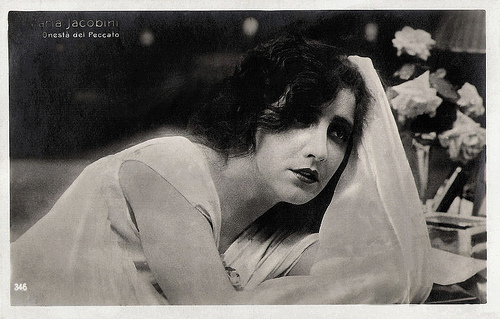
Italian postcard by Ed. Vettori, Bologna, no. 346. Sent by mail in 1926. Maria Jacobini in Onestà del Peccato/The Wife He Neglected (Augusto Genina, 1918).
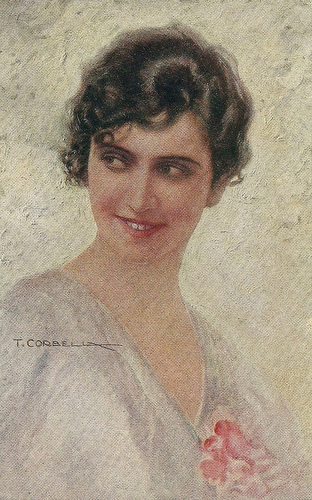
Italian postcard by Milano, Uff. Rev. Stampa, no. 891. Portrait of the actress Maria Jacobini by Tito Corbella.
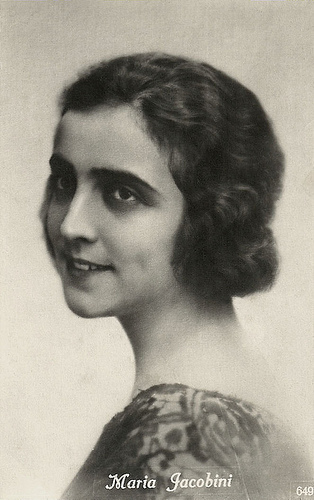
Italian postcard by Ed. Romeo Biagi, Bologna, no. 649.
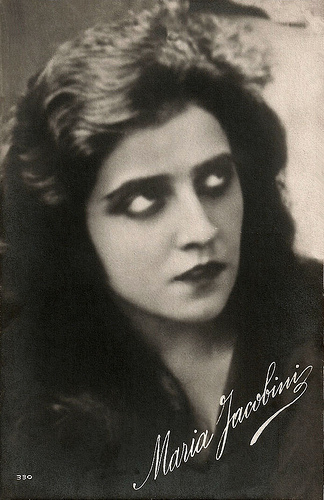
Italian postcard by Dist. Ed. SARPIC, Bucarest, Romania, no. 330.
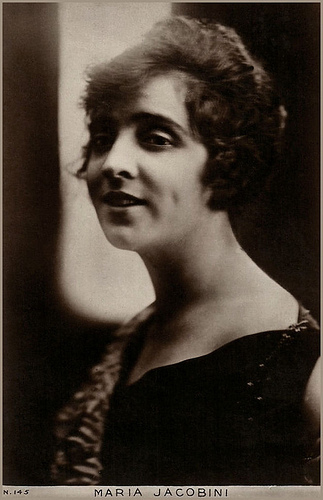
Italian postcard by Ed. Bettini, Roma, no. 145
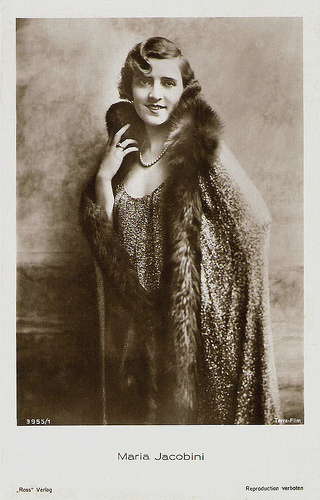
German postcard by Ross Verlag, no. 3953/1, 1928-1929. Photo: Terra-Film.
Seductive Man-eater
Maria Jacobini was born in Rome, Italy, 1892. She was the sister of actress Diomira Jacobini . Their older sister Bianca had also started out as an actress, but had interrupted her career after four films.
Maria studied at the Accademia di Arte Drammatica di S. Cecilia, where she got lessons from Virginia Marini and Eduardo Boutet. She made her stage debut at the company of Cesare Dondini jr., where she mainly played secondary parts.
She was noticed by Ugo Falena, artistic director of the film company Film d'Arte Italiana. He offered her to work in the silent cinema.
Her first short films were Lucrezia Borgia/Lucretia Borgia (Ugo Falena, 1910) featuring diva Francesca Bertini ,and Beatrice Cenci (Ugo Falena, 1910), but her first important role was in Cesare Borgia (Gerolamo Lo Savio, 1912) again starring Bertini.
In 1912, Maria started to work at the Savoia company of Turin, as a seductive man-eater in short films like Pantera/Panther (1912), La zingara/The gypsy (Sandro Camasio, 1912), and L'onta nascosta/The hidden shame (1912).
From 1913 on, she played her more dramatical roles as the lead in Giovanna d'Arco/Joan of Arc (Ubaldo Maria del Colle, 1913) and Ananke (Nino Oxilia, 1915) with Leda Gys and her sister Diomira Jacobini .
Jacobini worked for pioneering film studios like Pasquali and Celio. Maria gave good performances in the melancholic Come le foglie/Like the Leaves (Gennaro Righelli, 1916) based on Giuseppe Giacosa's stage play, and in the touching Addio Giovinezza/Good-bye Youth (Augusto Genina, 1918).
She made a series of films with director Gennaro Righelli such as Il viaggio/The journey (1921), based on a novel by Luigi Pirandello, and Cainà - la figlia dell'isola/Cainà - the daughter of the island (1923), shot in Sardinia.
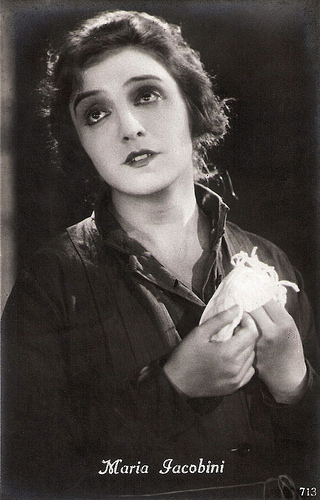
Italian postcard by Ed. A. Traldi, Milano, no. 713.
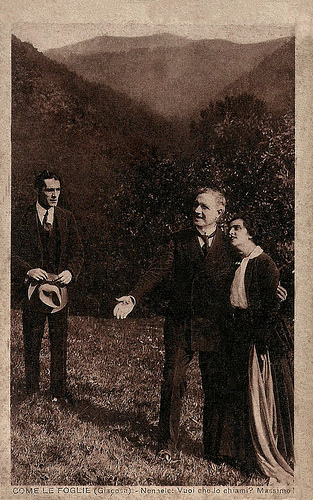
Italian postcard. Photo: Tiber Film. Publicity still for Come le foglie/Like the Leaves (Gennaro Righelli, 1917), based on the stage play by Giuseppe Giacosa. Father Giovanni (Ignazio Lupi) unites his daughter Nennele (Maria Jacobini) with his cousin Massimo (Guido Guiducci). Translation caption: Nennele: Shall I call him? Massimo! Content of the film: After a life of spendthrifts, the Rosati family is ruined. Father Giovanni (Ignazio Lupi) accepts work from his cousin Massimo (Guido Guiducci). Hitherto neglected as too serious and workaholic, Massimo becomes the head of the family and takes care of the son and daughter of Giovanni, Tommy ( Alberto Collo ) and Nennele (Jacobini), and their stepmother Giulia (Floriana). Tommy and Giulia remain weak spirits, but after an attempted suicide, Nennele realizes Massimo's force and unites with him.
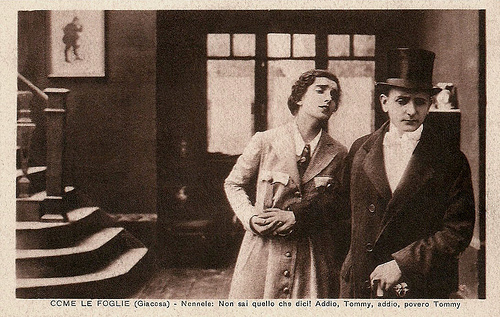
Italian postcard. Photo: Tiber Film, Roma. Publicity still for Come le foglie/Like the Leaves (Gennaro Righelli, 1917). Maria Jacobini (Nennele) and Alberto Collo (Tommy). Translation caption: Nennele: You don't know what you're saying! Farewell, Tommy, farewell, poor Tommy!
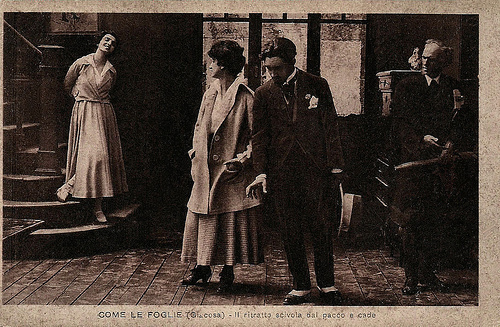
Italian postcard. Photo: Tiber Film, Roma. Publicity still for Come le foglie/Like the Leaves (Gennaro Righelli, 1917). Left Maria Jacobini. The man in the middle could be Guido Guiducci. Translation caption : The portrait slipped from the package and fell to the ground.
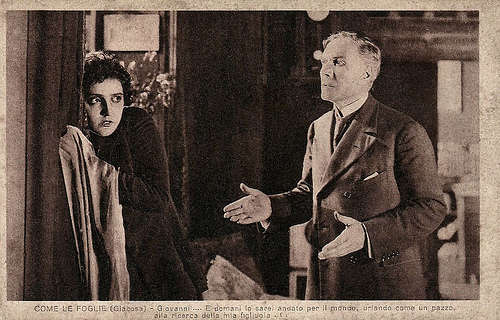
Italian postcard. Photo: Tiber Film, Roma. Publicity still of Maria Jacobini and Ignazio Lupi in the Italian silent film Come le foglie/Like the leaves (Gennaro Righelli, 1917), based on the stage play by Giuseppe Giacosa. The caption translates: 'Giovanni: And tomorrow I would have been out in the world, shouting like a madman, searching for my little daughter'.
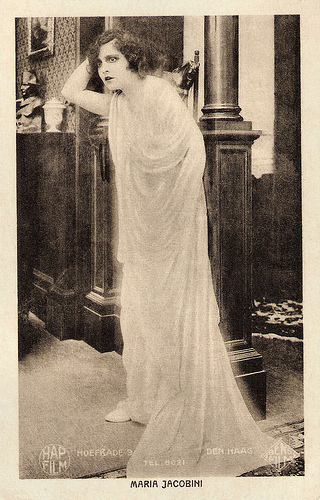
Dutch postcard by E & B, no. 518. Photo: HAP Film, Den Haag / Bens Film.
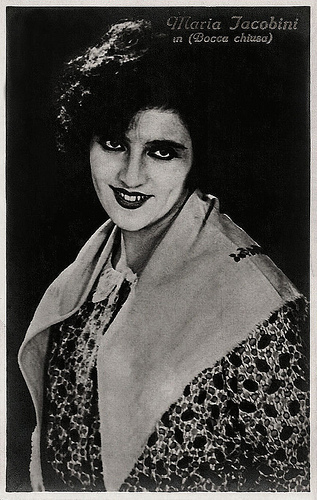
Italian postcard by G.B. Falci, Milano, no. 348. Maria Jacobini in the silent film La bocca chiusa (Guglielmo Zorzi, 1925).
Berlin
After the First World War, the Italian film industry was in a deep crisis, and director Gennaro Righelli and his star Maria Jacobini decided to move to Germany.
In Berlin, the new center of the European film industry, Jacobini and Righelli were enlisted by producer Jakob Karoll and they founded a separate company called Maria Jacobini GmbH.
Jacobini first starred in Bohème - Künstlerliebe/Bohème - artists love (Gennaro Righelli, 1923), playing the tormented and suffering Mimi. Her film partner was Wilhelm Dieterle , who would later become known as Hollywood director William Dieterle.
She often performed in Righelli's German films but also in films by other directors. She was directed by Jaap Speyer in Bigamie/Bigamy (1927), Robert Dinesen in Ariadne im Hoppegarten (1928) with Alfred Abel , Richard Oswald in Villa Falconieri (1928) opposite Hans Stüwe , and by Fedor Ozep in the German-Russian coproduction Der lebende Leichnam/Zhivoy trup/The Living Corpse (1929), based on the play by Leo Tolstoy.
These productions were shot all over Europe, and Jacobini even filmed in Africa for Die Frauengasse von Algier/The Street of Women of Algiers (Wolfgang Hoffmann-Harnisch, 1927) with Camilla Horn .
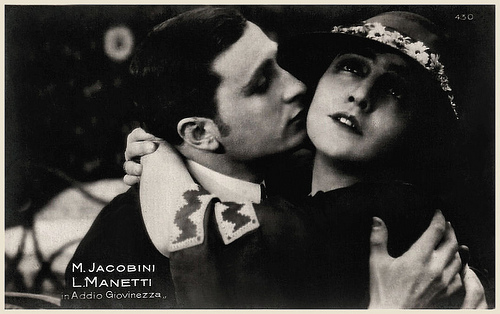
Italian postcard, no. 430. Photo: Maria Jacobini and Lido Manetti in the silent film Addio giovinezza/Good-bye youth (Augusto Genina, 1918), an adaptation of the play by Sandro Camasio and Nino Oxilia.
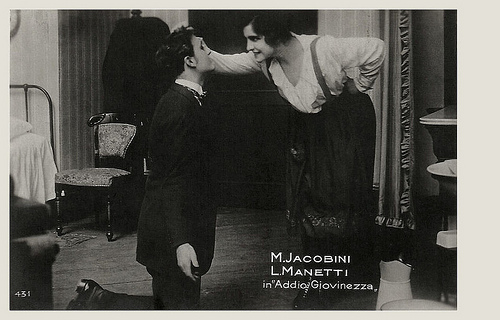
Italian postcard, no. 431. Photo: Maria Jacobini and Lido Manetti in the silent film Addio giovinezza/Good-bye youth (Augusto Genina, 1918).
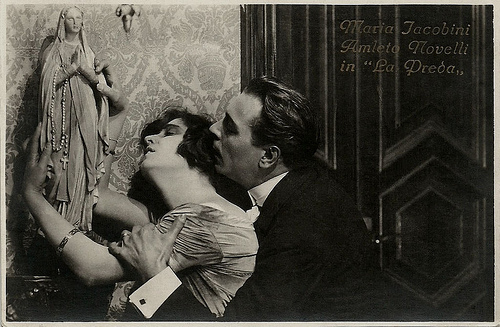
Italian postcard by G.B. Falci, Milano. Photo: publicity still for La preda/The prey (Guglielmo Zorzi, 1921) with Maria Jacobini and Amleto Novelli
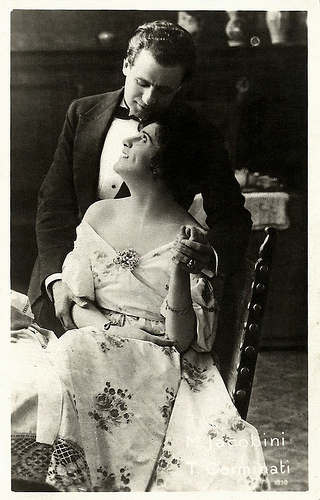
Italian postcard by Ed. Vettori, Bologna. Photo: probably a publicity still for L'articolo IV (Gennaro Righelli, 1918) in which Jacobini and Tullio Carminati were the leading actors. The film is about duchess Jenny who offers her hand to the only man who didn't court her, the count d'Hauteville. She has a condition, though: for a long time the two must first live together as mere friends and if they don't get along they will divorce. Will both keep this promise? The card suggests otherwise...
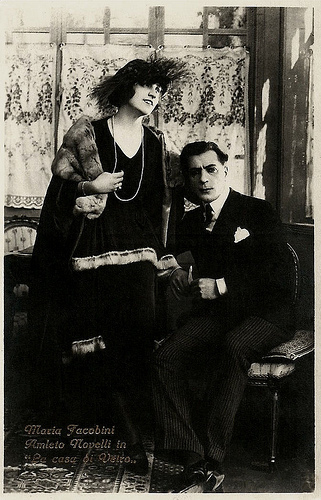 Italian postcard by G.B. Falci, Milano, no. 13. Photo: publicity still for La casa di vetro/The glass house (Gennaro Righelli, 1920) with Jacobini and
Amleto Novelli
.
Italian postcard by G.B. Falci, Milano, no. 13. Photo: publicity still for La casa di vetro/The glass house (Gennaro Righelli, 1920) with Jacobini and
Amleto Novelli
.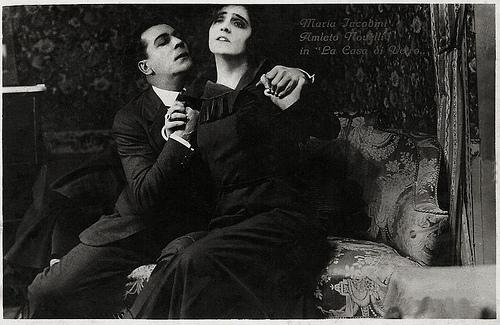
Italian postcard by G.B. Falci, Milano. Photo: publicity still for La casa di vetro/The glass house (Gennaro Righelli, 1920) with Jacobini and Amleto Novelli .
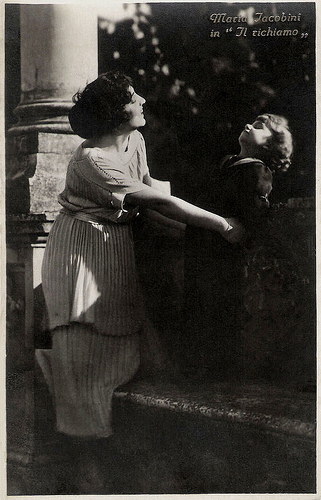
Italian postcard by G.B. Falci, Milano, no. 92. Photo: publicity still for Il richiamo/The Call (Gennaro Righelli, 1921).
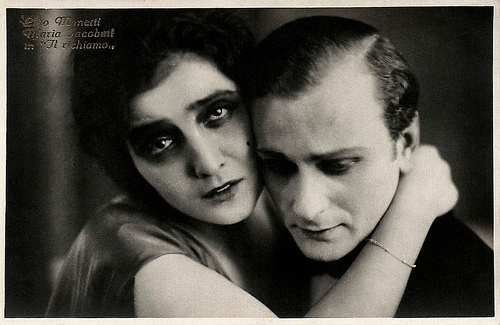
Italian postcard by G.B. Falci, Milano, no. 67. Publicity still of Maria Jacobini and Lido Manetti in Il richiamo/The Call (Gennaro Righelli, 1921). A print of this film is in the Komiya Collection at the National Film Center in Tokyo. A restored version was shown at the last edition of the festival Cinema Ritrovato in Bologna (June/July 2012).
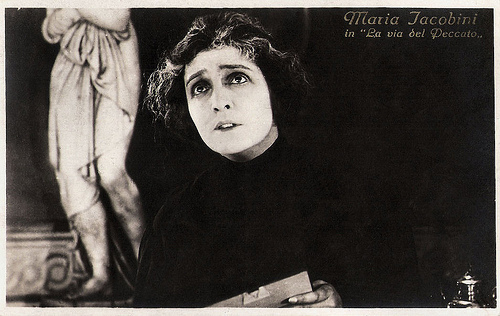
Italian postcard. Photo: publicity still for La via del peccato (Amleto Palermi, 1925).
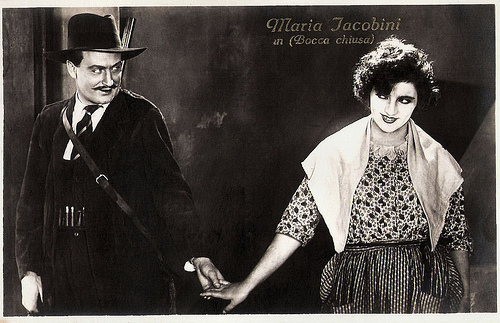
Italian postcard by G.B. Falci, Milano. Photo: Maria Jacobini in La bocca chiusa (Guglielmo Zorzi, 1925) with Lido Manetti .
Marginal Roles
In the second half of the 1920s, Maria Jacobini performed also in a few Italian films such as La bocca chiusa/Shut up(Guglielmo Zorzi, 1925) opposite Lido Manetti a.k.a. Arnold Kent and Carmen Boni , Beatrice Cenci (Baldassarre Negroni, 1926), and Il carnevale di Venezia/The carnival of Venice (Mario Almirante, 1928).
In France she did Maman Colibri/Mother Hummingbird (Julien Duvivier, 1929) with Franz Lederer . It was her final silent film.
With the coming of the sound cinema, Jacobini's roles became marginal, though she continued to play in films until her death.
In 1937 she became a teacher in acting at the new Roman film academy Centro Sperimentale di Cinematografia, where she gave lessons to new stars and actresses such as Alida Valli and Clara Calamai .
Her final film was La donna della montagna/The Mountain Woman (Renato Castellani, 1943) with Marina Berti .
Maria Jacobini died a year later, in 1944 in Rome. She was 52.
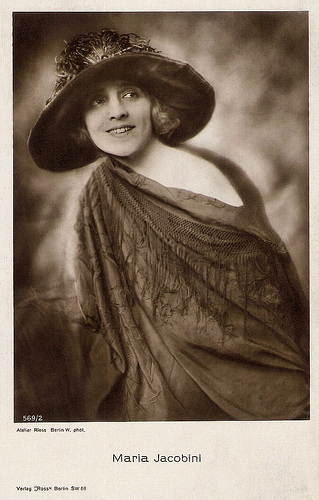
German postcard by Ross Verlag, no. 569/2, 1919-1924. Photo: Atelier Riess, Berlin.
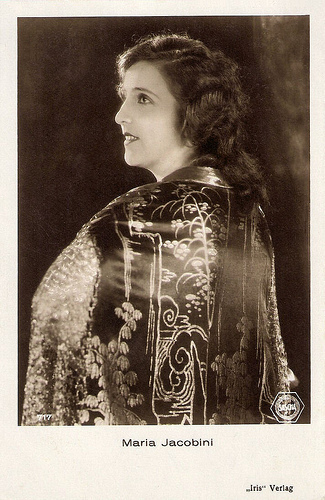
Austrian postcard by Iris Verlag, no. 717. Photo: Sascha Film.
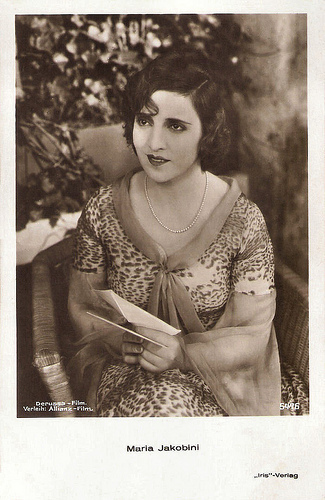
Austrian postcard by Iris Verlag, no. 5476. Photo: Derussa-Film / Allianz-Film.
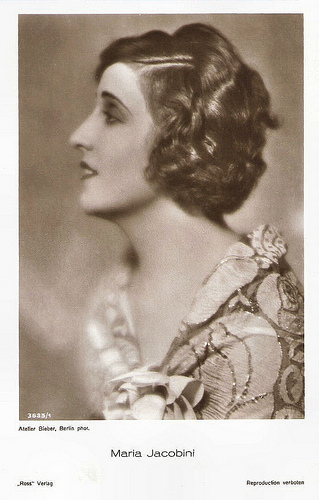
German postcard by Ross Verlag, Berlin, no. 3635/1, 1928-1929. Photo: Atelier Bieber, Berlin.
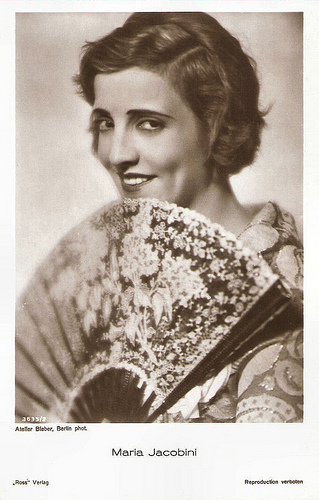
German postcard by Ross Verlag, no. 3635/2, 1928-1929. Photo: Atelier Bieber, Berlin.
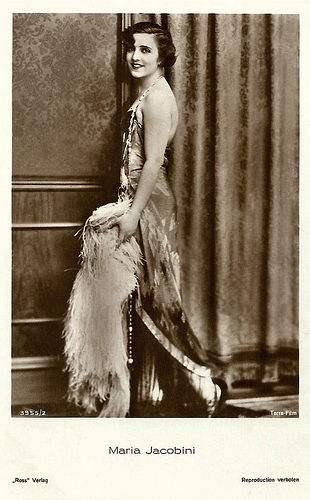
German postcard by Ross Verlag, no. 3955/2, 1928-1929. Photo: Terra-Film.
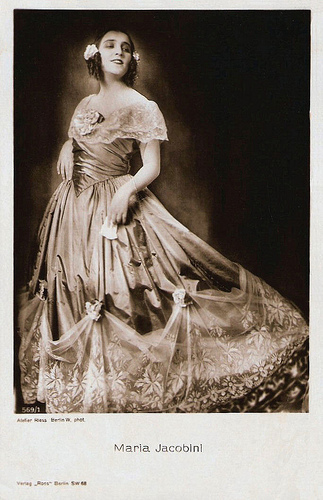
German postcard by Ross Verlag, Berlin, no. 569/1, 1930-1931. Photo: Atelier Riess, Berlin.
Sources: Vittorio Martinelli (Le dive del silenzio), Caterina Cerra (Treccani.it) (Italian), Wikipedia (English and Italian) and .
Published on June 27, 2014 23:00
June 26, 2014
Charles Chaplin
Tomorrow the Gates of Heaven will open for cinema lovers: the XXVIII edition of Il Cinema Ritrovato film festival starts at 28 June 2014! Actually, the festival is preceded from 25 till 28 June by The Birth of Tramp Celebration to celebrate the 100th anniversary of The Tramp. This iconic character of Charles ‘Charlie’ Chaplin (1889-1977) is one of the most creative and influential personalities of the silent-film era. The Tramp with his toothbrush moustache, undersized bowler hat and bamboo cane is little man who struggles to survive while keeping his dignity in a world with great social injustice. Chaplin used mime, slapstick and other visual comedy routines, and he not only starred in his films, but also directed, wrote and produced them, and composed the music as well. His working life in entertainment spanned over 75 years, from the Victorian stage and the music hall in the United Kingdom as a child performer, until his last work close to his death at the age of 88.
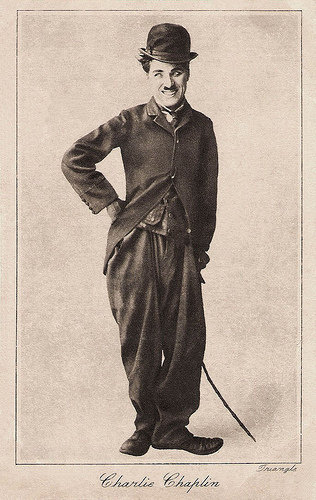
Vintage postcard. Photo: Triangle.
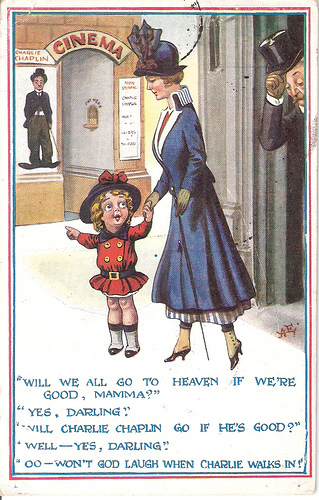
British postcard in the H. B. Series., 'Entire British Production', London E.C., sent by mail on 30.7.1917. Signature: AEI.
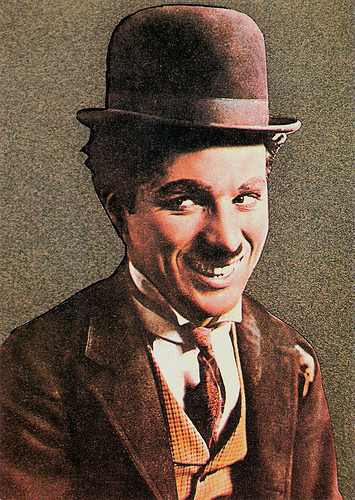
French postcard by Editions Nugeron, no. 76.
Music Hall Tradition
Charles Spencer Chaplin was born in 1889, in London, England. His parents were both entertainers in the Music Hall tradition; his father, Charles Spencer Chaplin Sr., was a vocalist and actor and his mother, Hannah Chaplin, a singer and actress with the the stage name Lilly Harley.
They separated before Charlie was three. Charlie lived with his mother and his older half-brother Sydney. Chaplin Sr. was an alcoholic and had little contact with his son, though Charlie and Sydney briefly lived with their father and his mistress, while their mentally ill mother lived at an asylum.
Hannah's first crisis came in 1894 when she was performing at The Canteen, a theatre in Aldershot, mainly frequented by rioters and soldiers. Hannah was injured by the objects the audience threw at her and she was booed off the stage. Backstage, she cried and argued with her manager.
Meanwhile, the five-year old Chaplin went on stage alone and sang a well-known tune at that time, Jack Jones. The young Chaplin brothers forged a close relationship in order to survive. They gravitated to the Music Hall while still very young, and both of them proved to have considerable natural stage talent.
At eight Charlie toured in a musical, The Eight Lancaster Lads. Nearly 11, he appeared in Giddy Ostende at London's Hippodrome. Chaplin's early years of desperate poverty were a great influence on his film characters. His films would later re-visit the scenes of his childhood deprivation in Lambeth.
In 1901, his father died of cirrhosis of the liver when Charlie was twelve. His mother died in 1928 in Hollywood, seven years after having been brought to the US by her sons.
Unknown to Charlie and Sydney until years later, they had a half-brother through their mother. The boy, Wheeler Dryden, was raised abroad by his father but later connected with the rest of the family and went to work for Chaplin at his Hollywood studio.
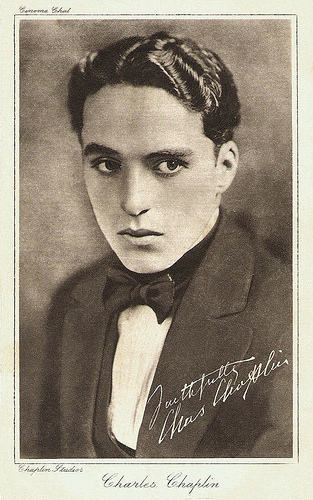
Vintage postcard. Photo: Chaplin Studios.
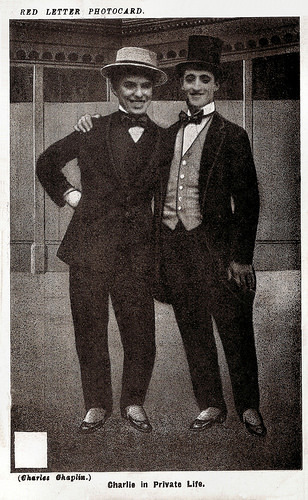
British postcard by Red Letter Photocard. Photo: Essanay.
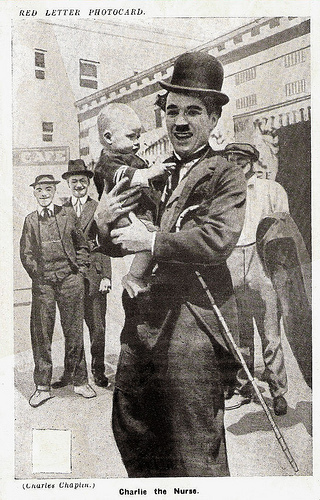
British postcard by Red Letter Photocard.
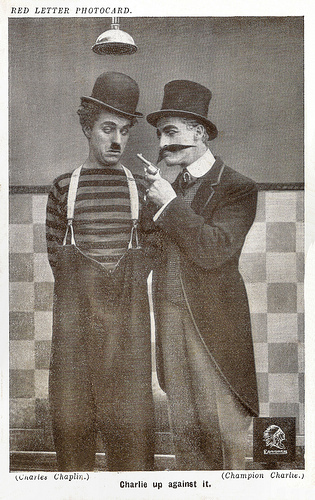
British postcard by Red Letter Photocard. Photo: Essanay. Publicity still for The Champion (Charles Chaplin, 1915) with Chaplin and Leo White.
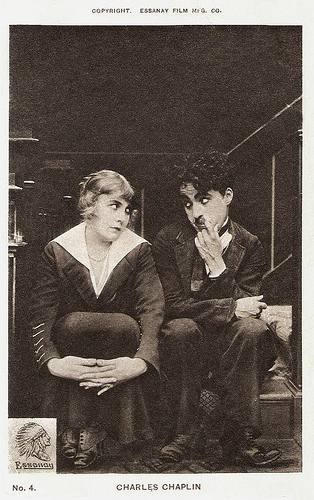
British postcard by Red Letter Photocard, no. 4. Photo: Essanay.
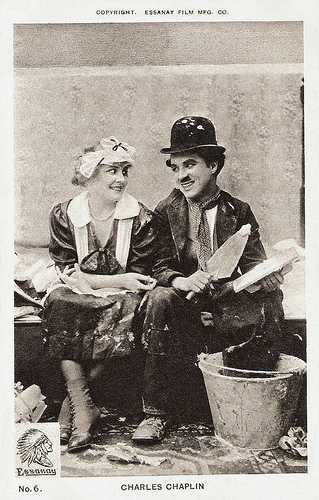
British postcard by Red Letter Photocard, no.6. Photo: Essanay. Publicity still for Work (1915) with Edna Purviance.
Fred Karno's Vaudeville Troupe
From age 17 to 24, Charlie Chaplin joined Fred Karno's English vaudeville troupe. He first toured the United States with the Fred Karno troupe from 1910 to 1912. After five months back in England, he returned to the US for a second tour. In the troupe was also his brother Sydney and Arthur Stanley Jefferson, who later became known as Stan Laurel.
In late 1913, Chaplin's act with the Karno troupe was seen by Mack Sennett, Mabel Normand, Minta Durfee, and Fatty Arbuckle. Sennett hired him for his studio, the Keystone Film Company as a replacement for Ford Sterling.
Chaplin had considerable initial difficulty adjusting to the demands of film acting and his performance suffered for it. After Chaplin's first film appearance, Making a Living (Henry Lehrman, 1914) was filmed, Sennett felt he had made a costly mistake.
Mabel Normand persuaded Sennett to give Chaplin another chance, and she directed and wrote a handful of his earliest films.
He first played The Tramp in the Keystone comedy Kid Auto Races at Venice (Henry Lehrman, 1914). This picture saw him wearing baggy pants borrowed from Roscoe 'Fatty' Arbuckle, size 14 shoes belonging to Ford Sterling (and worn upside down to keep them from falling off), a tiny jacket from Keystone Kop Charles Avery, a bowler hat belonging to Arbuckle's father-in-law and some crepe paper belonging to Mack Swain (which became the tramp's mustache). The only item that actually belonged to Charlie was the cane.
Two films Chaplin made in 1915, The Tramp and The Bank, created the characteristics of his screen persona.
Chaplin was influenced by his predecessor, the French silent film comedian Max Linder, to whom he dedicated one of his films. Quickly the little tramp became the most popular Keystone star.
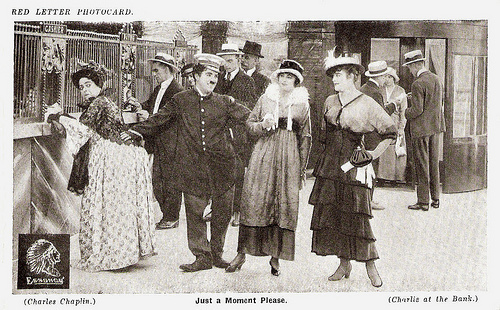
British postcard by Red Letter Photocard. Photo: Essanay. Publicity still for The Bank (1915).
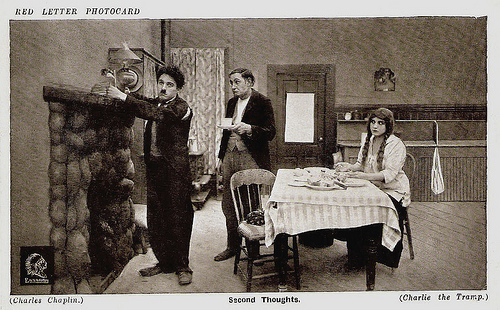
British postcard by Red Letter Photocard. Photo: Essanay. Publicity still for The Tramp (1915).
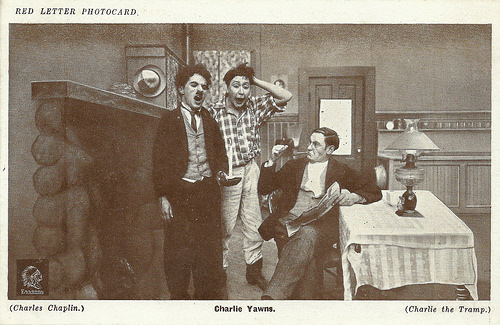
British postcard by Red Letter Photocard. Photo: Essanay. Publicity still for The Tramp (1915). Chaplin as the Tramp, Ernest Van Pelt as the Farmer and Paddy McGuire as the Farmhand.
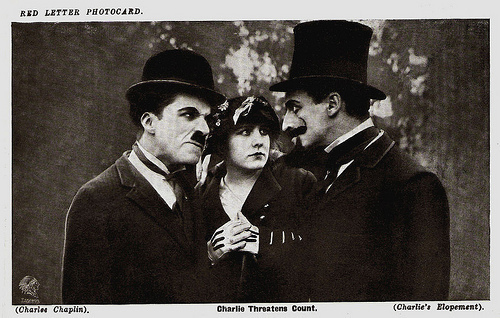
British postcard by Red Letter Photocard. Photo: Essanay. Publicity still for A Jitney Elopement (1915) with Charles Chaplin, Edna Purviance and Leo White.
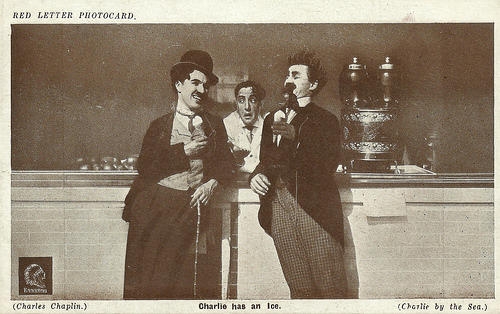
British postcard by Red Letter Photocard. Photo: Essanay. Chaplin and Billy Armstrong enjoy an ice cream after their fight in By the Sea (1915). The ice cream clerk is 'Snub' Pollard.
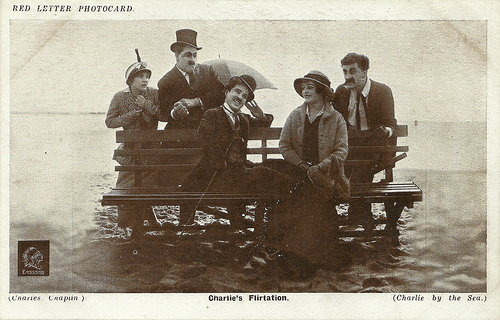
British postcard by Red Letter Photocard. Photo: Essanay. Chaplin and Margie Reiger flirt in By the Sea (1915), while Bud Jamison and Billy Armstrong are not too happy about this, and Edna Purviance fears trouble is coming up. The film was shot at Crystal Pear in Los Angeles.
Keystone, Essanay, Mutual, First National, United Artists
From the April 1914 one-reeler Twenty Minutes of Love (Charles Chaplin, Joseph Maddern, 1914) onwards, Charles Chaplin was writing and directing most of his films himself. By 1916 he was producing them, and from 1918 he was also composing the music.
He made 35 films in 1914, moved to Essanay in 1915 and did 14 more, then jumped over to Mutual for 12 two-reelers in 1916 and 1917.
In 1918 he joined First National (later absorbed by Warner Bros.) and in 1919 formed United Artists along with Douglas Fairbanks, Mary Pickford and D.W. Griffith.
His first full-length film was The Kid (1921) with Jackie Coogan; his first film for United Artists, which he produced and directed himself, was A Woman of Paris: A Drama of Fate (1923) starring Edna Purviance.
Chaplin continued to play The Tramp through dozens of short films and, later, feature-length productions. In only a handful of films he played different characters.
The Tramp was closely identified with the silent era, and was considered an international character; when the sound era began in the late 1920s, Chaplin refused to make a talkie featuring the character. City Lights (1931) featured no dialogue.
Chaplin officially retired the character in Modern Times (1936), which appropriately ended with the Tramp and his girl (played by Chaplin’s third wife, Paulette Godard) walking down an endless highway towards the horizon. The film was only a partial talkie and is often called the last silent film.
The Tramp remains silent until near the end of the film when, for the first time, his voice is finally heard, albeit only as part of a French/Italian-derived gibberish song. This allowed The Tramp to finally be given a voice but not tarnish his association with the silent era.
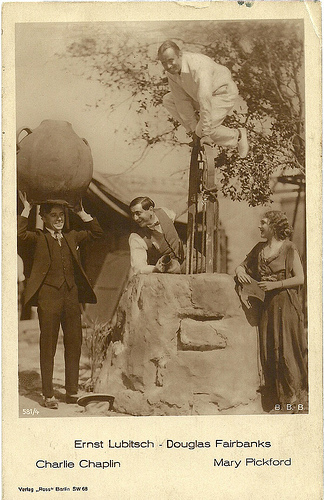
German postcard by Ross Verlag, Berlin, no. 581/4,1919-1924. Photo: B.B.B. Collection: Didier Hanson.
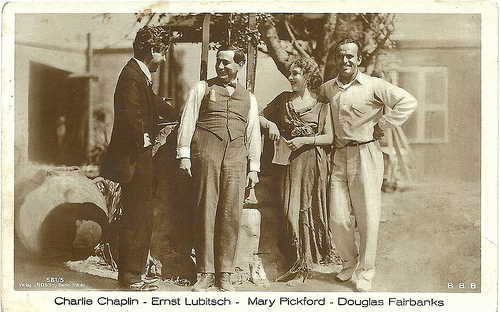
German postcard by Ross Verlag, no. 581/5, 1919-1924. Photo: B.B.B. Collection: Didier Hanson.
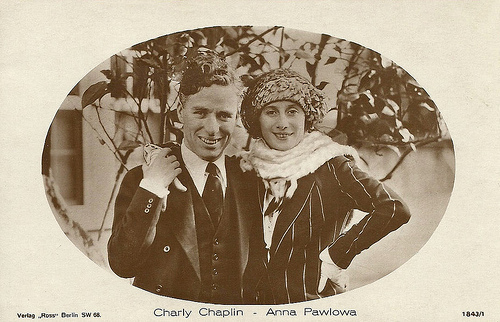
German postcard by Ross Verlag, Berlin, no. 1843/1, 1927-1928. Collection: Didier Hanson.
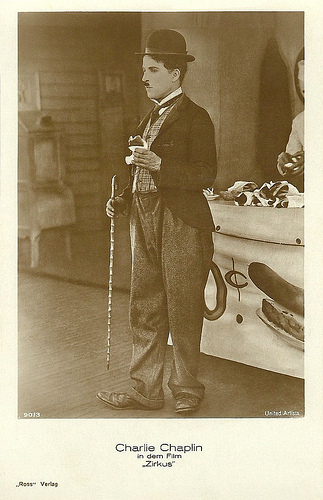
German postcard by Ross Verlag, Berlin, no. 90/3, 1925-1935. Photo: United Artists. Publicity still for The Circus (1928). Collection: Didier Hanson.
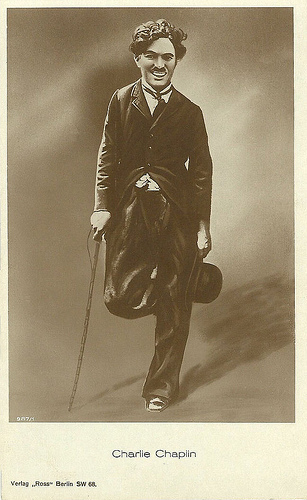
German postcard by Ross Verlag, Berlin, no. 987/1, 1925-1926. Collection: Didier Hanson.
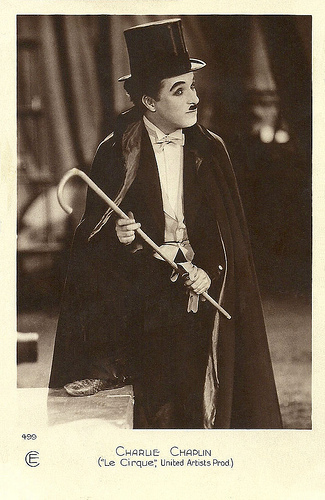
French postcard by Editions Cinematographiques, no. 499. Photo: United Artists. Publicity still for The Circus (1928). Collection: Didier Hanson.
Adulation and Controversy
Charlie Chaplin’s high-profile public and private life encompassed both adulation and controversy.
Chaplin's political ideas ultimately forced him to resettle in Europe during the McCarthy era in the early 1950s. Chaplin's political sympathies always had laid with the left. His silent films made prior to the Great Depression typically did not contain overt political themes or messages, apart from The Tramp's plight in poverty and his run-ins with the law, but his 1930s films were more openly political. Modern Times (1936) depicts workers and poor people in dismal conditions.
In The Great Dictator (1940) Chaplin plays a humorous caricature of Adolf Hitler. Some thought the film was poorly done and in bad taste. However, it grossed over $5 million and earned five Academy Award Nominations. The final dramatic speech in The Great Dictator, which was critical of following patriotic nationalism without question, and his vocal public support for the opening of a second European front in 1942 to assist the Soviet Union in World War II were controversial. Chaplin declined to support the war effort as he had done for the First World War which led to public anger, although his two sons saw service in the army in Europe.
For most of World War II he was fighting serious criminal and civil charges related to his involvement with 22-year old actress Joan Barry. In 1943 he was accused of fathering her child; the papers made much of the scandal, but it was proved in a court trial that he was not the father. The same year he entered his fourth marriage, to Oona O'Neill, daughter of playwright Eugene O'Neill.
After the war, his black comedy, Monsieur Verdoux (1947) showed a critical view of capitalism. Chaplin's final American film, Limelight, was less political and more autobiographical in nature. Limelight also featured Claire Bloom and Chaplin’s longtime friend, Buster Keaton.
In 1952, Chaplin left the US for what was intended as a brief trip home to the United Kingdom for the London premiere of Limelight. J. Edgar Hoover, head of the FBI, learned of the trip and negotiated with the Immigration and Naturalization Service to revoke Chaplin's re-entry permit, exiling Chaplin so he could not return for his alleged political leanings.

British postcard by Rotary, no 11675 A. Photo: Witzel.
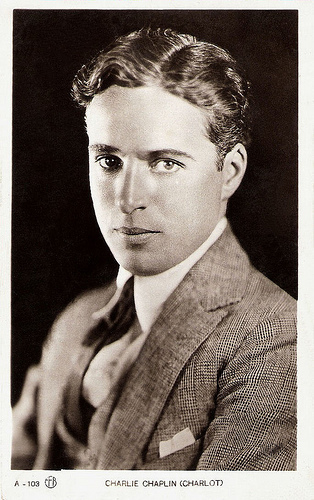
Spanish postcard by Editorial Photográfica, Barcelona, no. A - 103.
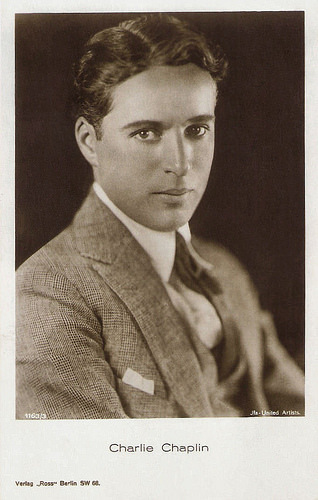
German postcard by Ross-Verlag, Berlin, no. 1163/3, 1927-1928. Photo: Ifa / United Artists.
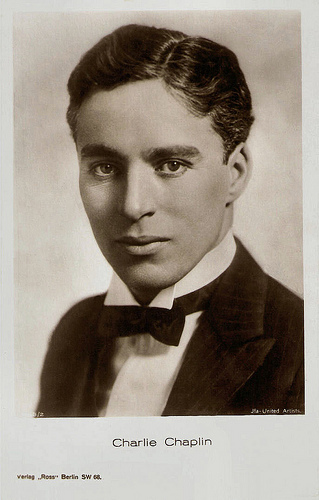
German postcard by Ross-Verlag, Berlin, no. 1165/2, 1927-1928. Photo: Ifa / United Artists.
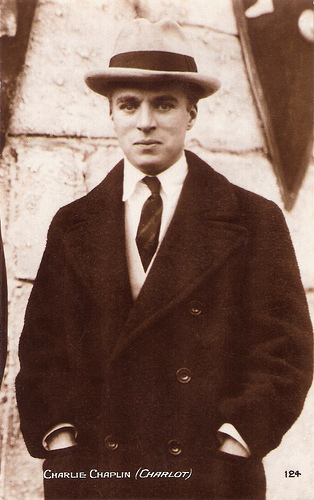
A fashionable Chaplin on a French postcard from the 1920s.
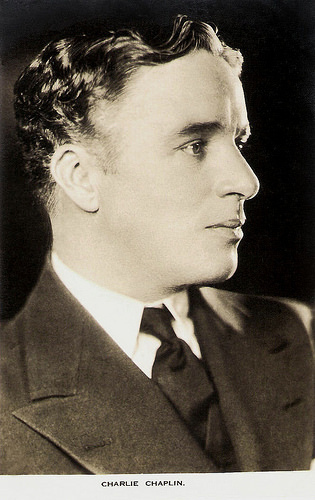
British postcard in the Film Weekly Series, London.
A King in Switzerland
Charles Chaplin made his home in Vevey, Switzerland. His final two films were made in London. A King in New York (1957),(in) which he starred, wrote, directed and produced, satirized the political persecution and paranoia that had forced him to leave the US five years earlier.
His last film, A Countess from Hong Kong (1967), which he directed, produced, and wrote, starred Sophia Loren and Marlon Brando. Chaplin made his final on-screen appearance in a brief cameo role as a seasick steward. He also composed the music for both films. The theme song from A Countess From Hong Kong, This is My Song, reached number one in the UK as sung by Petula Clark.
Chaplin also compiled a film The Chaplin Revue (1959) from three First National films A Dog's Life (1918), Shoulder Arms (1918) and The Pilgrim (1923) for which he composed the music and recorded an introductory narration.
As well as directing these final films, Chaplin also wrote My Autobiography, which was published in 1964. He briefly and triumphantly returned to the United States in April 1972, with his wife Oona, to receive an Honorary Oscar, and also to discuss how his films would be re-released and marketed.
Chaplin's last completed work was the score for his film A Woman of Paris (1923), which was completed in 1976, by which time Chaplin was extremely frail, even finding communication difficult. Charles Chaplin died in his sleep in Vevey on Christmas Day 1977. He and Oona had eight children, including film actress Geraldine Chaplin.
From his four marriages he had a total of 11 children. In 1921 Chaplin was decorated by the French government for his outstanding work as a filmmaker, and was elevated to the rank of Officer of the Legion of Honor in 1952.
In 1929, at the first Oscar awards, he won a special award "for versatility and genius in writing, acting, directing and producing" The Circus (1928). In 1975 he was named Knight Commander of the British Empire. His bowler and cane were sold for $150,000 in 1987. And in 1999, the American Film Institute ranked Chaplin the 10th Greatest Actor on The 50 Greatest Screen Legends list. Author George Bernard Shaw once called Chaplin "the only genius to come out of the movie industry".
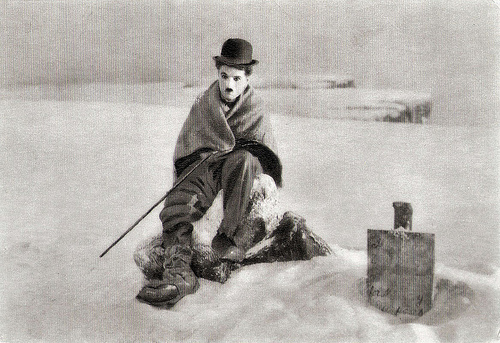
French postcard by Hélio-Cachan. Photo: publicity still for The Gold Rush (Charles Chaplin, 1925).
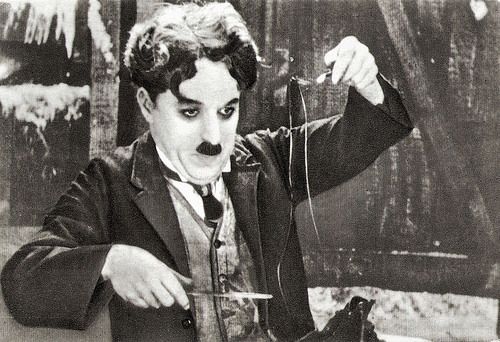
French postcard by Hélio-Cachan. Photo: publicity still for The Gold Rush (Charles Chaplin, 1925).
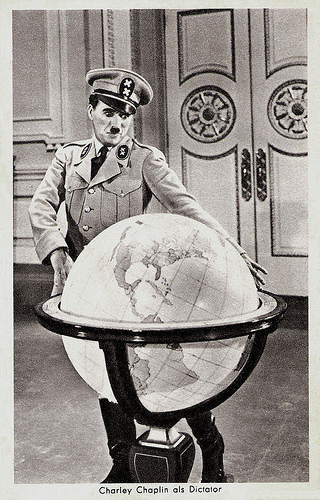
Dutch postcard. Sent by mail in the Netherlands in 1948. Photo: publicity still for The Great Dictator (1940).
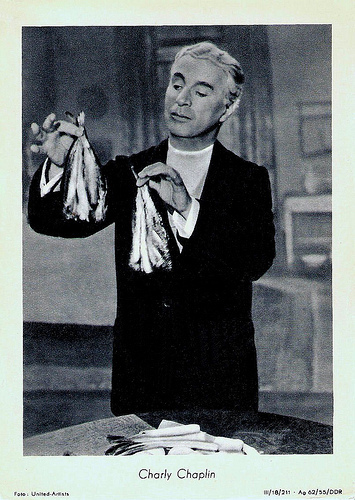
East-German collectors card, no. III/18/211, 1955. Photo: United Artists. Publicity still for Limelight (1952).
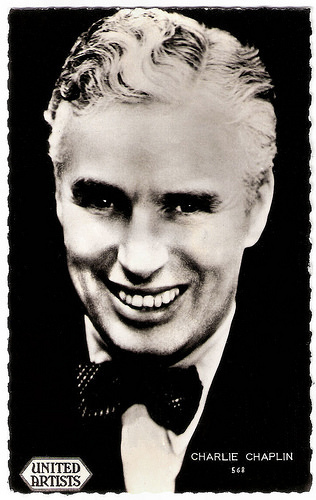
French postcard by Editions P.I., presented by Les Carbones Korès Carboplane, no. 568 Photo: United Artists.
Sources: (IMDb), (IMDb), Linda Wada (Edna's Place), Wikipedia and .

Vintage postcard. Photo: Triangle.

British postcard in the H. B. Series., 'Entire British Production', London E.C., sent by mail on 30.7.1917. Signature: AEI.

French postcard by Editions Nugeron, no. 76.
Music Hall Tradition
Charles Spencer Chaplin was born in 1889, in London, England. His parents were both entertainers in the Music Hall tradition; his father, Charles Spencer Chaplin Sr., was a vocalist and actor and his mother, Hannah Chaplin, a singer and actress with the the stage name Lilly Harley.
They separated before Charlie was three. Charlie lived with his mother and his older half-brother Sydney. Chaplin Sr. was an alcoholic and had little contact with his son, though Charlie and Sydney briefly lived with their father and his mistress, while their mentally ill mother lived at an asylum.
Hannah's first crisis came in 1894 when she was performing at The Canteen, a theatre in Aldershot, mainly frequented by rioters and soldiers. Hannah was injured by the objects the audience threw at her and she was booed off the stage. Backstage, she cried and argued with her manager.
Meanwhile, the five-year old Chaplin went on stage alone and sang a well-known tune at that time, Jack Jones. The young Chaplin brothers forged a close relationship in order to survive. They gravitated to the Music Hall while still very young, and both of them proved to have considerable natural stage talent.
At eight Charlie toured in a musical, The Eight Lancaster Lads. Nearly 11, he appeared in Giddy Ostende at London's Hippodrome. Chaplin's early years of desperate poverty were a great influence on his film characters. His films would later re-visit the scenes of his childhood deprivation in Lambeth.
In 1901, his father died of cirrhosis of the liver when Charlie was twelve. His mother died in 1928 in Hollywood, seven years after having been brought to the US by her sons.
Unknown to Charlie and Sydney until years later, they had a half-brother through their mother. The boy, Wheeler Dryden, was raised abroad by his father but later connected with the rest of the family and went to work for Chaplin at his Hollywood studio.

Vintage postcard. Photo: Chaplin Studios.

British postcard by Red Letter Photocard. Photo: Essanay.

British postcard by Red Letter Photocard.

British postcard by Red Letter Photocard. Photo: Essanay. Publicity still for The Champion (Charles Chaplin, 1915) with Chaplin and Leo White.

British postcard by Red Letter Photocard, no. 4. Photo: Essanay.

British postcard by Red Letter Photocard, no.6. Photo: Essanay. Publicity still for Work (1915) with Edna Purviance.
Fred Karno's Vaudeville Troupe
From age 17 to 24, Charlie Chaplin joined Fred Karno's English vaudeville troupe. He first toured the United States with the Fred Karno troupe from 1910 to 1912. After five months back in England, he returned to the US for a second tour. In the troupe was also his brother Sydney and Arthur Stanley Jefferson, who later became known as Stan Laurel.
In late 1913, Chaplin's act with the Karno troupe was seen by Mack Sennett, Mabel Normand, Minta Durfee, and Fatty Arbuckle. Sennett hired him for his studio, the Keystone Film Company as a replacement for Ford Sterling.
Chaplin had considerable initial difficulty adjusting to the demands of film acting and his performance suffered for it. After Chaplin's first film appearance, Making a Living (Henry Lehrman, 1914) was filmed, Sennett felt he had made a costly mistake.
Mabel Normand persuaded Sennett to give Chaplin another chance, and she directed and wrote a handful of his earliest films.
He first played The Tramp in the Keystone comedy Kid Auto Races at Venice (Henry Lehrman, 1914). This picture saw him wearing baggy pants borrowed from Roscoe 'Fatty' Arbuckle, size 14 shoes belonging to Ford Sterling (and worn upside down to keep them from falling off), a tiny jacket from Keystone Kop Charles Avery, a bowler hat belonging to Arbuckle's father-in-law and some crepe paper belonging to Mack Swain (which became the tramp's mustache). The only item that actually belonged to Charlie was the cane.
Two films Chaplin made in 1915, The Tramp and The Bank, created the characteristics of his screen persona.
Chaplin was influenced by his predecessor, the French silent film comedian Max Linder, to whom he dedicated one of his films. Quickly the little tramp became the most popular Keystone star.

British postcard by Red Letter Photocard. Photo: Essanay. Publicity still for The Bank (1915).

British postcard by Red Letter Photocard. Photo: Essanay. Publicity still for The Tramp (1915).

British postcard by Red Letter Photocard. Photo: Essanay. Publicity still for The Tramp (1915). Chaplin as the Tramp, Ernest Van Pelt as the Farmer and Paddy McGuire as the Farmhand.

British postcard by Red Letter Photocard. Photo: Essanay. Publicity still for A Jitney Elopement (1915) with Charles Chaplin, Edna Purviance and Leo White.

British postcard by Red Letter Photocard. Photo: Essanay. Chaplin and Billy Armstrong enjoy an ice cream after their fight in By the Sea (1915). The ice cream clerk is 'Snub' Pollard.

British postcard by Red Letter Photocard. Photo: Essanay. Chaplin and Margie Reiger flirt in By the Sea (1915), while Bud Jamison and Billy Armstrong are not too happy about this, and Edna Purviance fears trouble is coming up. The film was shot at Crystal Pear in Los Angeles.
Keystone, Essanay, Mutual, First National, United Artists
From the April 1914 one-reeler Twenty Minutes of Love (Charles Chaplin, Joseph Maddern, 1914) onwards, Charles Chaplin was writing and directing most of his films himself. By 1916 he was producing them, and from 1918 he was also composing the music.
He made 35 films in 1914, moved to Essanay in 1915 and did 14 more, then jumped over to Mutual for 12 two-reelers in 1916 and 1917.
In 1918 he joined First National (later absorbed by Warner Bros.) and in 1919 formed United Artists along with Douglas Fairbanks, Mary Pickford and D.W. Griffith.
His first full-length film was The Kid (1921) with Jackie Coogan; his first film for United Artists, which he produced and directed himself, was A Woman of Paris: A Drama of Fate (1923) starring Edna Purviance.
Chaplin continued to play The Tramp through dozens of short films and, later, feature-length productions. In only a handful of films he played different characters.
The Tramp was closely identified with the silent era, and was considered an international character; when the sound era began in the late 1920s, Chaplin refused to make a talkie featuring the character. City Lights (1931) featured no dialogue.
Chaplin officially retired the character in Modern Times (1936), which appropriately ended with the Tramp and his girl (played by Chaplin’s third wife, Paulette Godard) walking down an endless highway towards the horizon. The film was only a partial talkie and is often called the last silent film.
The Tramp remains silent until near the end of the film when, for the first time, his voice is finally heard, albeit only as part of a French/Italian-derived gibberish song. This allowed The Tramp to finally be given a voice but not tarnish his association with the silent era.

German postcard by Ross Verlag, Berlin, no. 581/4,1919-1924. Photo: B.B.B. Collection: Didier Hanson.

German postcard by Ross Verlag, no. 581/5, 1919-1924. Photo: B.B.B. Collection: Didier Hanson.

German postcard by Ross Verlag, Berlin, no. 1843/1, 1927-1928. Collection: Didier Hanson.

German postcard by Ross Verlag, Berlin, no. 90/3, 1925-1935. Photo: United Artists. Publicity still for The Circus (1928). Collection: Didier Hanson.

German postcard by Ross Verlag, Berlin, no. 987/1, 1925-1926. Collection: Didier Hanson.

French postcard by Editions Cinematographiques, no. 499. Photo: United Artists. Publicity still for The Circus (1928). Collection: Didier Hanson.
Adulation and Controversy
Charlie Chaplin’s high-profile public and private life encompassed both adulation and controversy.
Chaplin's political ideas ultimately forced him to resettle in Europe during the McCarthy era in the early 1950s. Chaplin's political sympathies always had laid with the left. His silent films made prior to the Great Depression typically did not contain overt political themes or messages, apart from The Tramp's plight in poverty and his run-ins with the law, but his 1930s films were more openly political. Modern Times (1936) depicts workers and poor people in dismal conditions.
In The Great Dictator (1940) Chaplin plays a humorous caricature of Adolf Hitler. Some thought the film was poorly done and in bad taste. However, it grossed over $5 million and earned five Academy Award Nominations. The final dramatic speech in The Great Dictator, which was critical of following patriotic nationalism without question, and his vocal public support for the opening of a second European front in 1942 to assist the Soviet Union in World War II were controversial. Chaplin declined to support the war effort as he had done for the First World War which led to public anger, although his two sons saw service in the army in Europe.
For most of World War II he was fighting serious criminal and civil charges related to his involvement with 22-year old actress Joan Barry. In 1943 he was accused of fathering her child; the papers made much of the scandal, but it was proved in a court trial that he was not the father. The same year he entered his fourth marriage, to Oona O'Neill, daughter of playwright Eugene O'Neill.
After the war, his black comedy, Monsieur Verdoux (1947) showed a critical view of capitalism. Chaplin's final American film, Limelight, was less political and more autobiographical in nature. Limelight also featured Claire Bloom and Chaplin’s longtime friend, Buster Keaton.
In 1952, Chaplin left the US for what was intended as a brief trip home to the United Kingdom for the London premiere of Limelight. J. Edgar Hoover, head of the FBI, learned of the trip and negotiated with the Immigration and Naturalization Service to revoke Chaplin's re-entry permit, exiling Chaplin so he could not return for his alleged political leanings.

British postcard by Rotary, no 11675 A. Photo: Witzel.

Spanish postcard by Editorial Photográfica, Barcelona, no. A - 103.

German postcard by Ross-Verlag, Berlin, no. 1163/3, 1927-1928. Photo: Ifa / United Artists.

German postcard by Ross-Verlag, Berlin, no. 1165/2, 1927-1928. Photo: Ifa / United Artists.

A fashionable Chaplin on a French postcard from the 1920s.

British postcard in the Film Weekly Series, London.
A King in Switzerland
Charles Chaplin made his home in Vevey, Switzerland. His final two films were made in London. A King in New York (1957),(in) which he starred, wrote, directed and produced, satirized the political persecution and paranoia that had forced him to leave the US five years earlier.
His last film, A Countess from Hong Kong (1967), which he directed, produced, and wrote, starred Sophia Loren and Marlon Brando. Chaplin made his final on-screen appearance in a brief cameo role as a seasick steward. He also composed the music for both films. The theme song from A Countess From Hong Kong, This is My Song, reached number one in the UK as sung by Petula Clark.
Chaplin also compiled a film The Chaplin Revue (1959) from three First National films A Dog's Life (1918), Shoulder Arms (1918) and The Pilgrim (1923) for which he composed the music and recorded an introductory narration.
As well as directing these final films, Chaplin also wrote My Autobiography, which was published in 1964. He briefly and triumphantly returned to the United States in April 1972, with his wife Oona, to receive an Honorary Oscar, and also to discuss how his films would be re-released and marketed.
Chaplin's last completed work was the score for his film A Woman of Paris (1923), which was completed in 1976, by which time Chaplin was extremely frail, even finding communication difficult. Charles Chaplin died in his sleep in Vevey on Christmas Day 1977. He and Oona had eight children, including film actress Geraldine Chaplin.
From his four marriages he had a total of 11 children. In 1921 Chaplin was decorated by the French government for his outstanding work as a filmmaker, and was elevated to the rank of Officer of the Legion of Honor in 1952.
In 1929, at the first Oscar awards, he won a special award "for versatility and genius in writing, acting, directing and producing" The Circus (1928). In 1975 he was named Knight Commander of the British Empire. His bowler and cane were sold for $150,000 in 1987. And in 1999, the American Film Institute ranked Chaplin the 10th Greatest Actor on The 50 Greatest Screen Legends list. Author George Bernard Shaw once called Chaplin "the only genius to come out of the movie industry".

French postcard by Hélio-Cachan. Photo: publicity still for The Gold Rush (Charles Chaplin, 1925).

French postcard by Hélio-Cachan. Photo: publicity still for The Gold Rush (Charles Chaplin, 1925).

Dutch postcard. Sent by mail in the Netherlands in 1948. Photo: publicity still for The Great Dictator (1940).

East-German collectors card, no. III/18/211, 1955. Photo: United Artists. Publicity still for Limelight (1952).

French postcard by Editions P.I., presented by Les Carbones Korès Carboplane, no. 568 Photo: United Artists.
Sources: (IMDb), (IMDb), Linda Wada (Edna's Place), Wikipedia and .
Published on June 26, 2014 23:00
Jacques Bergerac (1927-2014)
On 15 June, French actor Jacques Bergerac died at his home in Anglet in the Pyrenees-Atlantiques region of southwest France. He made a name for himself in European and Hollywood films such as the classic musical Gigi (1958) and the cult horror film Hypnotic Eye (1960). Bergerac also married two of Hollywood’s most sought-after actresses during the 1950s and 1960s. He was 87.
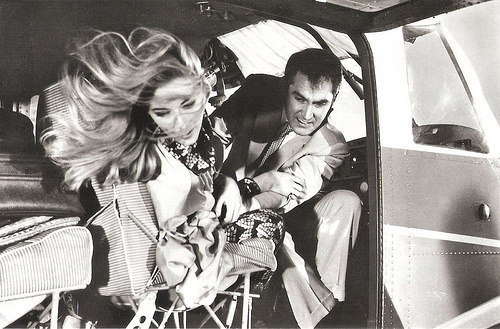
Romanian postcard by Casa Filmului Acin. Photo: Publicity still for Missione speciale Lady Chaplin/Operation Lady Chaplin (Alberto De Martino, Sergio Grieco, 1966) with Daniela Bianchi and Jacques Bergerac.
Beautiful Stranger
Jacques Bergerac was born in Biarritz, France in 1927.
He was a handsome law student, when he met Hollywood star Ginger Rogers on vacation in France. She landed him a screen test, which led to a role in the British film Beautiful Stranger/Twist of Fate (David Miller, 1954) which was shot on location at the French Riviera.
The 26-years-old Bergerac became in 1953 the fourth husband of the Oscar-winning actress, who was 16 years his senior. He left his law studies behind in France and went with Rogers to Hollywood to pursue an acting career.
He played supporting parts in the drama Strange Intruder (Irving Rapper, 1956) and in the French film Marie-Antoinette reine de France/Marie Antoinette Queen of France (Jean Delannoy, 1956) starring Michèle Morgan .
After his divorce from Rogers in 1957, Bergerac courted Academy Award-winning actress Dorothy Malone and they married in 1959 in Hong Kong.
Bergerac received favourable reviews for his work in the musicals Les Girls (George Cukor, 1957) with Gene Kelly, and Gigi (Vincente Minnelli, 1958) starring Leslie Caron . In 1957, he received the Golden Globe Award for Best Foreign Newcomer.
In the horror film The Hypnotic Eye (George Blair, 1960) he played a mysterious hypnotist who entrances women to gruesomely disfigure themselves. Mike Barnes at The Hollywood Reporter: "The film introduced 'HypnoMagic', billed as an “amazing new audience thrill that makes YOU part of the show!” The effect had Bergerac’s character, Desmond, looking directly into the camera and performing hypnotic suggestibility tests with the audience."
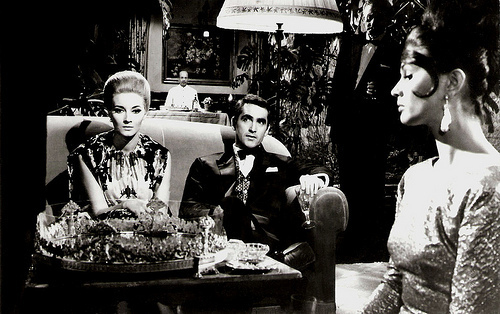
Romanian postcard by Casa Filmului Acin. Photo: Publicity still for Missione speciale Lady Chaplin/Operation Lady Chaplin (Alberto De Martino, Sergio Grieco, 1966) with Daniela Bianchi .
A Global Affair
Jacques Bergerac gained his US citizenship in 1963. A year later his rocky marriage to Dorothy Malone ended in a divorce and ensuing custody battles often played out in the press.
During the 1960s, he appeared in a slew of international B-films and guest-starred in popular American TV shows.
His films include the American thriller Fear No More (Bernard Wiesen, 1961), the Italian comedy Una domenica d'estate/Always on Sunday (Giulio Petroni, 1962) with Jean-Pierre Aumont , the Peplum L'ira di Achille/Fury of Achilles (Marino Girolami, 1962), the Bob Hope comedy A Global Affair (Jack Arnold. 1964), Ettore Scola's comedy La congiuntura/One Million Dollars (1964) with Vittorio Gassman and Joan Collins , and the Eurospy film Missione speciale Lady Chaplin/Operation Lady Chaplin (Alberto De Martino, Sergio Grieco, 1966) with Daniela Bianchi .
In between he appeared in episodes of such popular TV series as The Dick Van Dyke Show (1963), Perry Mason (1964), The Beverly Hillbillies (1967), The Lucy Show (1967) and Batman (1967-1968).
His last TV appearance was on The Doris Day Show in 1969.
After leaving show business, Bergerac returned to Paris and in 1971, he became an exec with Revlon Cosmetics and Parfums Balmain. His brother Michel later became president and the chairman of the company.
After a brief third marriage in 1968, Bergerac married again in 1975.
He was a sports enthusiast and in 1980-1981, he was director of the Biarritz Olympique rugby club.
Jacques Bergerac is survived by two daughters, Mimi and Diane, with Dorothy Malone.
Special Mission Lady Chaplin (1966) trailer. Source: Dorado Films (YouTube).
Sources: Jordyn Holman (Variety), Mike Barnes (The Hollywood Reporter), Brian J. Walker (Brian's Drive-In Theater), Ouest France (French), Wikipedia and .

Romanian postcard by Casa Filmului Acin. Photo: Publicity still for Missione speciale Lady Chaplin/Operation Lady Chaplin (Alberto De Martino, Sergio Grieco, 1966) with Daniela Bianchi and Jacques Bergerac.
Beautiful Stranger
Jacques Bergerac was born in Biarritz, France in 1927.
He was a handsome law student, when he met Hollywood star Ginger Rogers on vacation in France. She landed him a screen test, which led to a role in the British film Beautiful Stranger/Twist of Fate (David Miller, 1954) which was shot on location at the French Riviera.
The 26-years-old Bergerac became in 1953 the fourth husband of the Oscar-winning actress, who was 16 years his senior. He left his law studies behind in France and went with Rogers to Hollywood to pursue an acting career.
He played supporting parts in the drama Strange Intruder (Irving Rapper, 1956) and in the French film Marie-Antoinette reine de France/Marie Antoinette Queen of France (Jean Delannoy, 1956) starring Michèle Morgan .
After his divorce from Rogers in 1957, Bergerac courted Academy Award-winning actress Dorothy Malone and they married in 1959 in Hong Kong.
Bergerac received favourable reviews for his work in the musicals Les Girls (George Cukor, 1957) with Gene Kelly, and Gigi (Vincente Minnelli, 1958) starring Leslie Caron . In 1957, he received the Golden Globe Award for Best Foreign Newcomer.
In the horror film The Hypnotic Eye (George Blair, 1960) he played a mysterious hypnotist who entrances women to gruesomely disfigure themselves. Mike Barnes at The Hollywood Reporter: "The film introduced 'HypnoMagic', billed as an “amazing new audience thrill that makes YOU part of the show!” The effect had Bergerac’s character, Desmond, looking directly into the camera and performing hypnotic suggestibility tests with the audience."

Romanian postcard by Casa Filmului Acin. Photo: Publicity still for Missione speciale Lady Chaplin/Operation Lady Chaplin (Alberto De Martino, Sergio Grieco, 1966) with Daniela Bianchi .
A Global Affair
Jacques Bergerac gained his US citizenship in 1963. A year later his rocky marriage to Dorothy Malone ended in a divorce and ensuing custody battles often played out in the press.
During the 1960s, he appeared in a slew of international B-films and guest-starred in popular American TV shows.
His films include the American thriller Fear No More (Bernard Wiesen, 1961), the Italian comedy Una domenica d'estate/Always on Sunday (Giulio Petroni, 1962) with Jean-Pierre Aumont , the Peplum L'ira di Achille/Fury of Achilles (Marino Girolami, 1962), the Bob Hope comedy A Global Affair (Jack Arnold. 1964), Ettore Scola's comedy La congiuntura/One Million Dollars (1964) with Vittorio Gassman and Joan Collins , and the Eurospy film Missione speciale Lady Chaplin/Operation Lady Chaplin (Alberto De Martino, Sergio Grieco, 1966) with Daniela Bianchi .
In between he appeared in episodes of such popular TV series as The Dick Van Dyke Show (1963), Perry Mason (1964), The Beverly Hillbillies (1967), The Lucy Show (1967) and Batman (1967-1968).
His last TV appearance was on The Doris Day Show in 1969.
After leaving show business, Bergerac returned to Paris and in 1971, he became an exec with Revlon Cosmetics and Parfums Balmain. His brother Michel later became president and the chairman of the company.
After a brief third marriage in 1968, Bergerac married again in 1975.
He was a sports enthusiast and in 1980-1981, he was director of the Biarritz Olympique rugby club.
Jacques Bergerac is survived by two daughters, Mimi and Diane, with Dorothy Malone.
Special Mission Lady Chaplin (1966) trailer. Source: Dorado Films (YouTube).
Sources: Jordyn Holman (Variety), Mike Barnes (The Hollywood Reporter), Brian J. Walker (Brian's Drive-In Theater), Ouest France (French), Wikipedia and .
Published on June 26, 2014 16:05
June 25, 2014
Alfred Gerasch
Alfred Gerasch (1877-1954) was a popular Austrian stage actor who belonged to the exclusive circle of the ‘Königlich-Kaiserlichen Hofschauspielern’ (Royal Court Actors). He also acted in several silent and sound films, often playing historical figures.
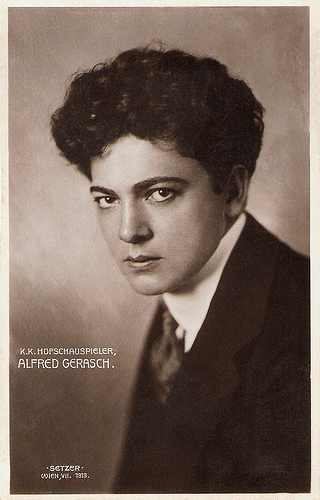
Austrian postcard by Postkartenverlag Brüder Kohn, Wien (Vienna). Photo: Setzer, Wien, 1913.
Royal Court Actor
Alfred Gerasch was born in Berlin in 1877. He made his stage debut at the Bellevue Theatre in Szczecin (now Poland). In 1897 he moved to Hamburg, and later to Oldenburg and to Karlsruhe. In 1907, he went to Vienna, where he was an ensemble member of the famous Burgtheater.
He became very popular among the Viennese theatre audiences as the young hero and lover in plays like Romeo and Juliet by William Shakespeare and Don Karlos by Friedrich Schiller.
Many great roles in the classic plays followed and the charismatic Gerasch was named ‘kaiserlich und königlichen Hofschauspieler’ (Royal Court Actor).
In 1919, the then 42-years old actor made his film debut in the role of the son of the main character in the Austrian production Adrian Vanderstraaten (Robert Land, 1919), followed by films like Durch die Quartiere des Elends und Verbrechens/Through the Neighborhoods of Misery and Crime (Robert Land, 1920) and Eine Million Dollar/One Million Dollar (Jacob Fleck, Luise Fleck 1921).
He returned to Berlin where he worked both for the stage and for the film industry. During the 1920s he appeared in such silent films as Die Legende von der heiligen Simplicia/The Legend of Holy Simplicity (Joe May, 1920) starring Eva May , Dagfin (Joe May, 1926) with Paul Richter , Eine Dubarry von heute/A Modern Dubarry (Alexander Korda, 1927) featuring María Corda , and Königin Luise, 2. Teil/Queen Luise, part 2 (Karl Grune, 1928) with Mady Christians .
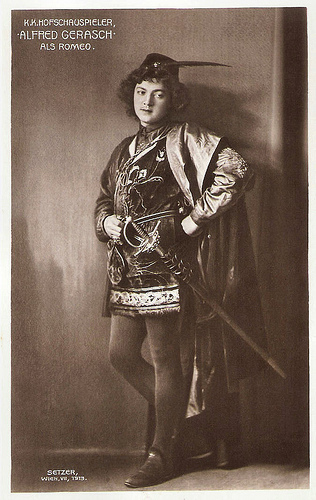
Austrian postcard by Postkartenverlag Brüder Kohn, Wien (Vienna). Photo: Setzer, Wien, 1913. Caption: "Alfred Gerasch als Romeo." (Alfred Gerasch as Romeo). Publicity still for a stage production of the play Romeo and Juliet by William Shakespeare.
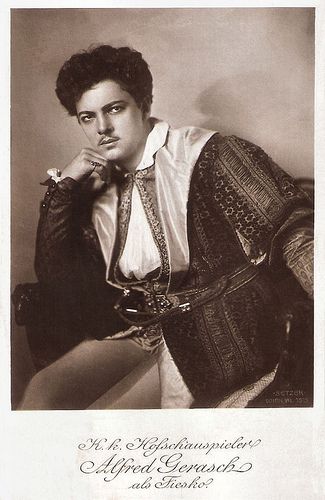
Austrian postcard by Postkartenverlag Brüder Kohn, Wien (Vienna), no. 887-1835. Photo: Setzer, Wien, 1913. Caption: K.k. Hofschauspieler Alfred Gerasch als Fiesko. Die Verschwörung des Fiesco zu Genua/Fiesco was the second full-length play by Friedrich Schiller. It is a republican tragedy based on the historical conspiracy of Giovanni Luigi Fieschi against Andrea Doria in Genoa in 1547. It premiered in Bonn in 1783 at the Hoftheater.
Historical Figures
After the introduction of sound film, Alfred Gerasch continued to play various supporting roles in films.
He often appeared as historical figures including Czar Alexander I in Napoleon auf St. Helena/Napoleon on St. Helena (Lupu Pick, 1929) with Werner Krauss , the Austrian-Hungarian chief of staff, Baron Franz Conrad von Hötzendorf in 1914, die letzten Tage vor dem Weltbrand/1914, The Last days Before the World Fire (Richard Oswald, 1931), the Austrian statesman Prince Metternich in Marschall vorwärts/Marshal Forward (Heinz Paul, 1932), Talleyrand - Napoleon’s Minister of Foreign Affairs in Hundert Tage/Hundred Days (Franz Wenzler, 1935), and Field Marshal General Daun in Fridericus (Johannes Meyer, 1937) starring Otto Gebühr .
From 1937 on, Gerasch lived in Vienna, Austria and his only film work from that period were a few guest appearances. He did appear in Zauber der Bohème/The Magic of Bohème (Géza von Bolváry, 1937), a film operetta tailor-made to the dream couple Jan Kiepura and Marta Eggerth . For this film he also served as co-author.
After 1945 he limited his work even more. His last film part was Roman emperor and philosopher Marcus Aurelius in the comedy Die Welt dreht sich verkehrt/The World Turns Upside Down (J.A. Hübler-Kahla, 1947) starring Hans Moser . He was 70 at the time.
Alfred Gerasch died in 1954 in Vienna.
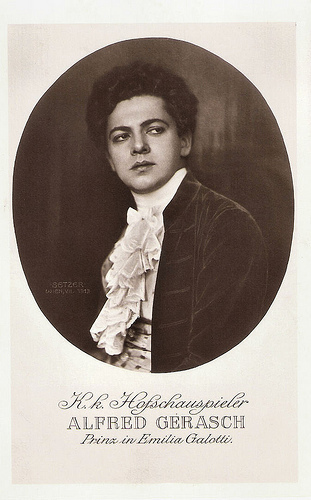
Austrian postcard by Postkartenverlag Brüder Kohn, Wien (Vienna). Photo: Setzer, Wien, 1913. Caption: "Prinz in Emilia Galotti." (Prince in Emilia Galotti). Emilia Galotti is a play in five acts by Gotthold Ephraim Lessing (1729–1781), which premiered on 8 March 1772 in Braunschweig (Brunswick). The work is a classic example of German 'bürgerliches Trauerspiel' (bourgeois tragedy). Lessing's work comprises an attack against the nobility and its powers. Lessing depicts aristocrats as having unfair powers in society and as ruining the happiness of the emerging middle class.
Sources: Stephanie D’heil (Steffi-line.de) (German), Thomas Staedeli (Cyranos), Wikipedia (German) and .

Austrian postcard by Postkartenverlag Brüder Kohn, Wien (Vienna). Photo: Setzer, Wien, 1913.
Royal Court Actor
Alfred Gerasch was born in Berlin in 1877. He made his stage debut at the Bellevue Theatre in Szczecin (now Poland). In 1897 he moved to Hamburg, and later to Oldenburg and to Karlsruhe. In 1907, he went to Vienna, where he was an ensemble member of the famous Burgtheater.
He became very popular among the Viennese theatre audiences as the young hero and lover in plays like Romeo and Juliet by William Shakespeare and Don Karlos by Friedrich Schiller.
Many great roles in the classic plays followed and the charismatic Gerasch was named ‘kaiserlich und königlichen Hofschauspieler’ (Royal Court Actor).
In 1919, the then 42-years old actor made his film debut in the role of the son of the main character in the Austrian production Adrian Vanderstraaten (Robert Land, 1919), followed by films like Durch die Quartiere des Elends und Verbrechens/Through the Neighborhoods of Misery and Crime (Robert Land, 1920) and Eine Million Dollar/One Million Dollar (Jacob Fleck, Luise Fleck 1921).
He returned to Berlin where he worked both for the stage and for the film industry. During the 1920s he appeared in such silent films as Die Legende von der heiligen Simplicia/The Legend of Holy Simplicity (Joe May, 1920) starring Eva May , Dagfin (Joe May, 1926) with Paul Richter , Eine Dubarry von heute/A Modern Dubarry (Alexander Korda, 1927) featuring María Corda , and Königin Luise, 2. Teil/Queen Luise, part 2 (Karl Grune, 1928) with Mady Christians .

Austrian postcard by Postkartenverlag Brüder Kohn, Wien (Vienna). Photo: Setzer, Wien, 1913. Caption: "Alfred Gerasch als Romeo." (Alfred Gerasch as Romeo). Publicity still for a stage production of the play Romeo and Juliet by William Shakespeare.

Austrian postcard by Postkartenverlag Brüder Kohn, Wien (Vienna), no. 887-1835. Photo: Setzer, Wien, 1913. Caption: K.k. Hofschauspieler Alfred Gerasch als Fiesko. Die Verschwörung des Fiesco zu Genua/Fiesco was the second full-length play by Friedrich Schiller. It is a republican tragedy based on the historical conspiracy of Giovanni Luigi Fieschi against Andrea Doria in Genoa in 1547. It premiered in Bonn in 1783 at the Hoftheater.
Historical Figures
After the introduction of sound film, Alfred Gerasch continued to play various supporting roles in films.
He often appeared as historical figures including Czar Alexander I in Napoleon auf St. Helena/Napoleon on St. Helena (Lupu Pick, 1929) with Werner Krauss , the Austrian-Hungarian chief of staff, Baron Franz Conrad von Hötzendorf in 1914, die letzten Tage vor dem Weltbrand/1914, The Last days Before the World Fire (Richard Oswald, 1931), the Austrian statesman Prince Metternich in Marschall vorwärts/Marshal Forward (Heinz Paul, 1932), Talleyrand - Napoleon’s Minister of Foreign Affairs in Hundert Tage/Hundred Days (Franz Wenzler, 1935), and Field Marshal General Daun in Fridericus (Johannes Meyer, 1937) starring Otto Gebühr .
From 1937 on, Gerasch lived in Vienna, Austria and his only film work from that period were a few guest appearances. He did appear in Zauber der Bohème/The Magic of Bohème (Géza von Bolváry, 1937), a film operetta tailor-made to the dream couple Jan Kiepura and Marta Eggerth . For this film he also served as co-author.
After 1945 he limited his work even more. His last film part was Roman emperor and philosopher Marcus Aurelius in the comedy Die Welt dreht sich verkehrt/The World Turns Upside Down (J.A. Hübler-Kahla, 1947) starring Hans Moser . He was 70 at the time.
Alfred Gerasch died in 1954 in Vienna.

Austrian postcard by Postkartenverlag Brüder Kohn, Wien (Vienna). Photo: Setzer, Wien, 1913. Caption: "Prinz in Emilia Galotti." (Prince in Emilia Galotti). Emilia Galotti is a play in five acts by Gotthold Ephraim Lessing (1729–1781), which premiered on 8 March 1772 in Braunschweig (Brunswick). The work is a classic example of German 'bürgerliches Trauerspiel' (bourgeois tragedy). Lessing's work comprises an attack against the nobility and its powers. Lessing depicts aristocrats as having unfair powers in society and as ruining the happiness of the emerging middle class.
Sources: Stephanie D’heil (Steffi-line.de) (German), Thomas Staedeli (Cyranos), Wikipedia (German) and .
Published on June 25, 2014 23:00
Paul van Yperen's Blog
- Paul van Yperen's profile
- 13 followers
Paul van Yperen isn't a Goodreads Author
(yet),
but they
do have a blog,
so here are some recent posts imported from
their feed.



